How to Get to the Top of Google Search Results for Free
Ranking at the top of Google can take time. Google prefers to rank websites with a trusted online reputation. And that have built their industry authority through high-quality content.
But newer websites can improve their visibility in Google. And get more eyes on their products and services.
By the end of this guide, you’ll know exactly what to do to get to the top of Google search results.
How Do Google Search Results Work?
Understanding how Google works can help you confirm that your webpages qualify for ranking well.
Google finds and ranks sites using a three-step process:
- Crawling: Google’s bots, or “spiders,” begin by scouring the web’s links. They follow links to search for new or updated webpages and download text, images, and videos.
- Indexing: Google examines the data from the URLs it found. It looks at what’s on each page, including text, images, and other media. All this info is stored in a giant database called the Google index.
- Serving: Finally, Google decides which pages best match specific search queries. Google search algorithms use ranking factors to decide which pages to show at the top.
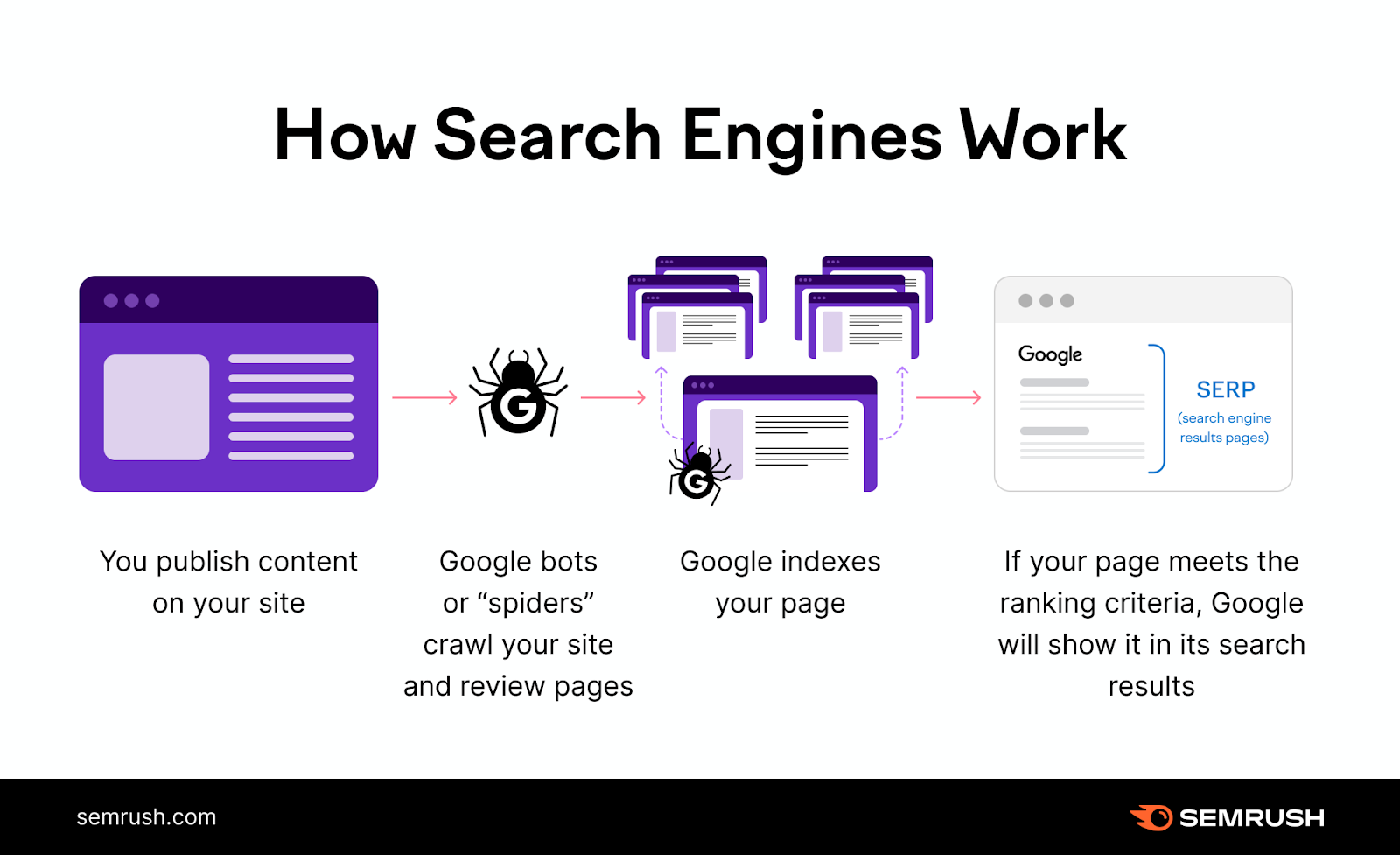
Further reading: Read more about how Google works in our guide to SEO.
Google uses thousands of signals (i.e., ranking factors) when determining which results to show on a search engine results page (SERP). And those signals can change, as Google updates its algorithms all the time.
But certain confirmed ranking factors have remained consistent over time. As they are the primary signals Google uses when serving its results.
Some of the most important are:
- Meaning and intent: Google’s algorithm uses advanced language models to figure out exactly what users are looking for based on the search query. And matches those queries with content that best meets that search intent.
- Relevance: Google analyzes a webpage’s content to assess whether it contains information that is relevant to what users are searching. The most basic signal of a page’s relevancy is when it contains the same keywords as the query.
- Quality: Google values authoritative content that shows expertise and trustworthiness. Google looks at backlinks from reputable sources and various other indicators to determine a page’s quality. It also considers how helpful content is and whether it leaves users feeling satisfied.
- User experience: Google values user experience, determined by factors like mobile-friendliness and page speed. A mobile-friendly site ensures content is accessible and usable across devices. Fast-loading pages provide a smoother experience, especially for users on slower networks.
- Context and location: Google personalizes results based on a user’s location, search history, and preferences. For instance, if you search “pizza,” Google may tailor results to local pizza places based on your location.
By understanding these factors, you can tailor your website and content to align with how Google ranks websites.
Which gives your webpages a better shot at landing those prime search result spots.
What Are the Benefits of Being at the Top of Google Search?
Billions of people use Google. And the top few Google results get most of the attention from those billions.
More specifically, the top five results on a Google search engine results page (SERP) have a collective organic click-through rate (CTR) of almost 70%.

This means that the higher you rank, the more likely users are to click on your link in search results.
Some additional benefits include:
- Consistent web traffic: The more of your site’s pages that rank in search results, the more opportunities you have to get website traffic
- Highly targeted: When done correctly, SEO strategies like keyword research can help you rank for the search terms that drive the most qualified traffic to your website (i.e., the users who are most likely to convert)
- Better reputation and credibility: Appearing in search results for common keywords and topics related to your industry builds your reputation and credibility
- Long-term benefits: Top-ranking webpages can produce ongoing traffic results. Unlike paid ads, where the results stop as soon as you stop investing.
- Cost-effective: You don’t have to pay when a user clicks on your organic result. So earning more traffic, leads, and sales through organic search can help lower your marketing costs.
10 Tips to Get to the Top of Google Search Results
1. Target the Right Keywords
Each of your webpages should be optimized for a different keyword or search query to maximize your opportunities to appear at the top of results.
But some keywords are more likely to drive results for your business than others. So it’s important to target the right ones.
Keyword research is the process of identifying those search terms. Which keywords are best will depend on your marketing goals, your website authority, and the competitive landscape of your niche.
Let’s say you’re in charge of SEO at a women’s fashion brand. And your goal is to get your page to the top of Google so you can sell more of a particular product.
First, open the Keyword Magic Tool from Semrush.
Enter your seed keyword, (i.e., a broad term related to your products, services, or topics you’d like to rank for). In this case, we used “dress with pockets.”
Then, add your homepage URL. Select the country your target audience is in. Then click “Search.”
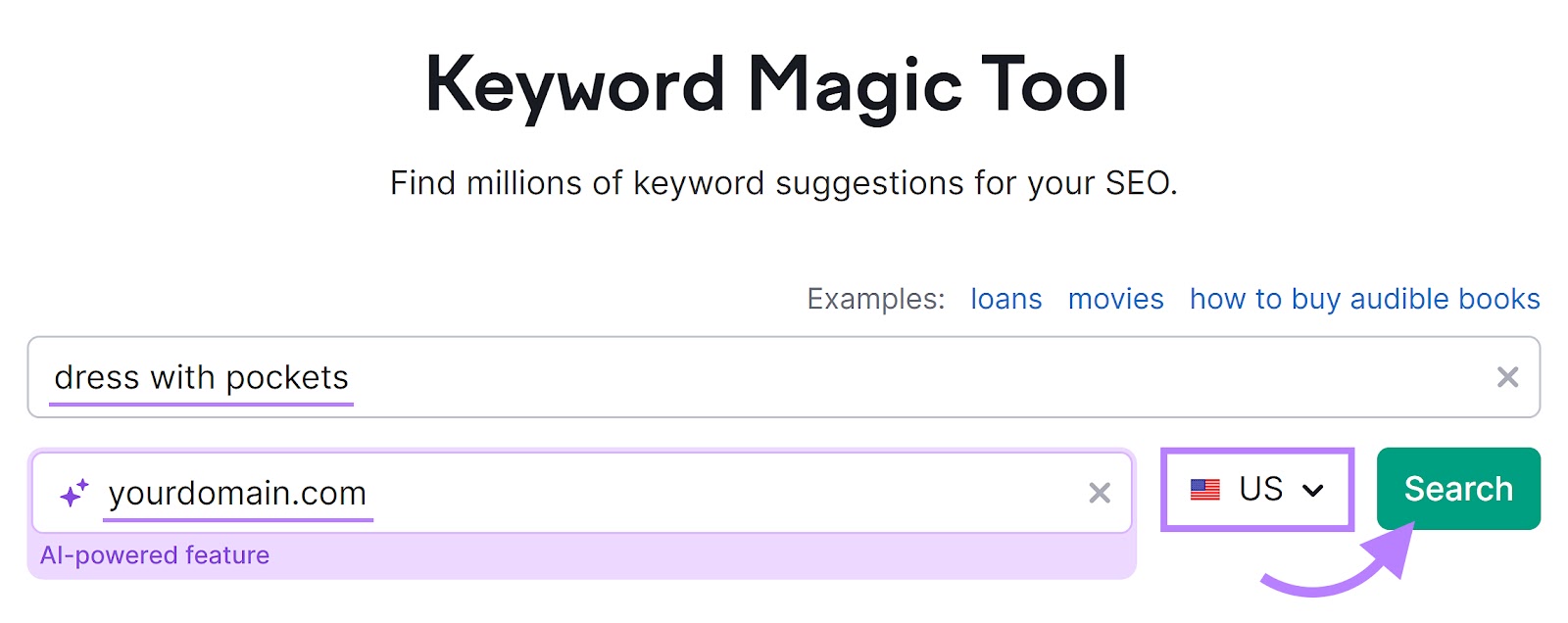
You’ll see thousands of keywords related to your seed keyword. If you have a webpage already ranking, you’ll see your current position noted to the right of the keyword.
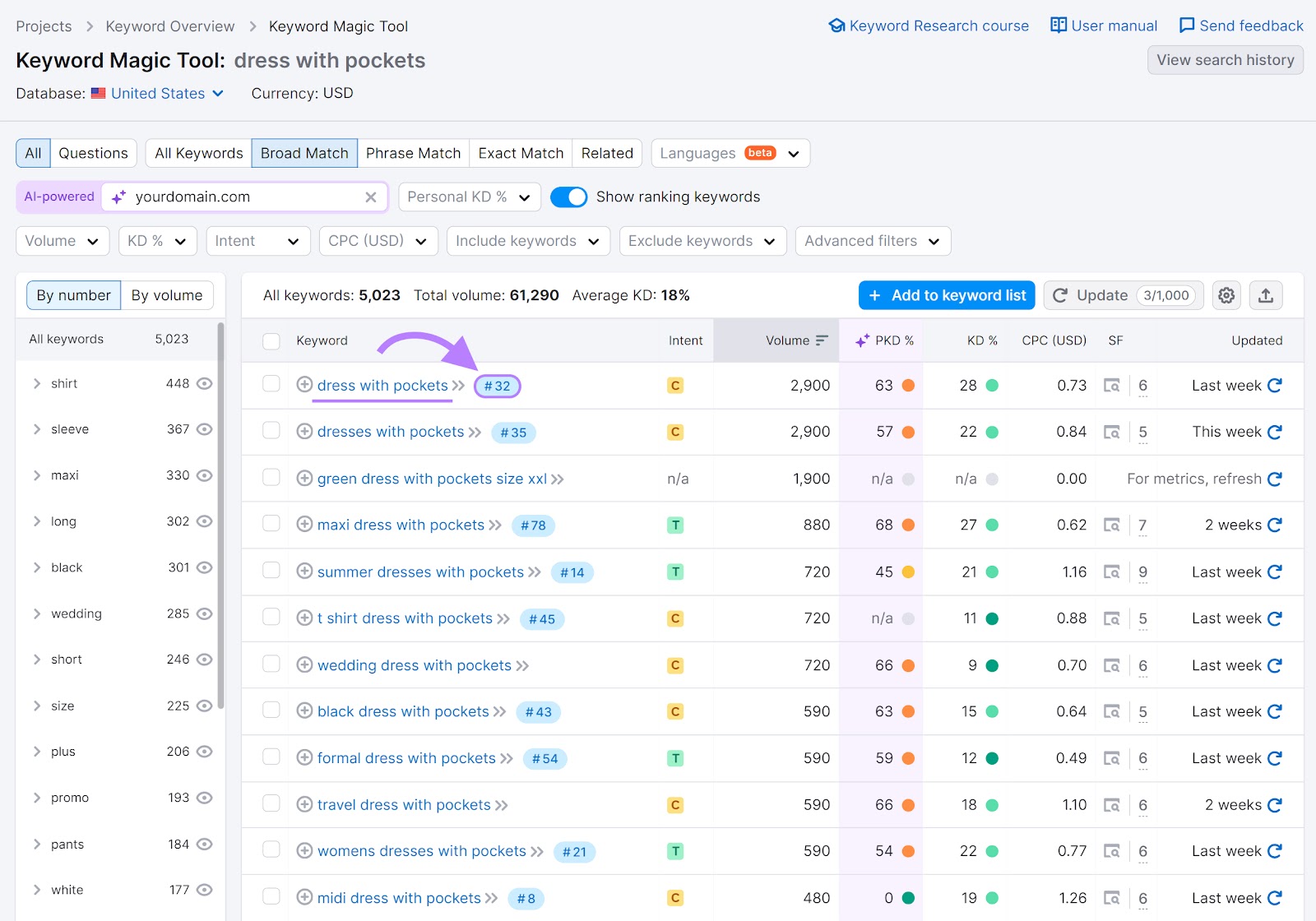
But don’t get overwhelmed. Here’s what to pay attention to:
- Volume: The estimated number of times a keyword is searched for per month. You want keywords you target to have a significant volume.
- Personal Keyword Difficulty (KD%): How difficult it is for your website to rank well for the keyword based on your website’s current authority and content. The higher the score, the more difficult it will be to rank at the top of results.
- Search intent: What searchers want to find when they use a specific keyword
You can narrow your list of keywords using the filters at the top of the table.
Let’s say you want to narrow the list to terms with the lowest PKD%. As those will provide the best opportunity for your website to rank near the top of results and drive traffic sooner.
Click on the “Personal KD %” drop-down menu. Select “Possible,” “Easy,” or “Very Easy.” Or enter a specific range underneath the “Custom range” option. Then click “Apply.”
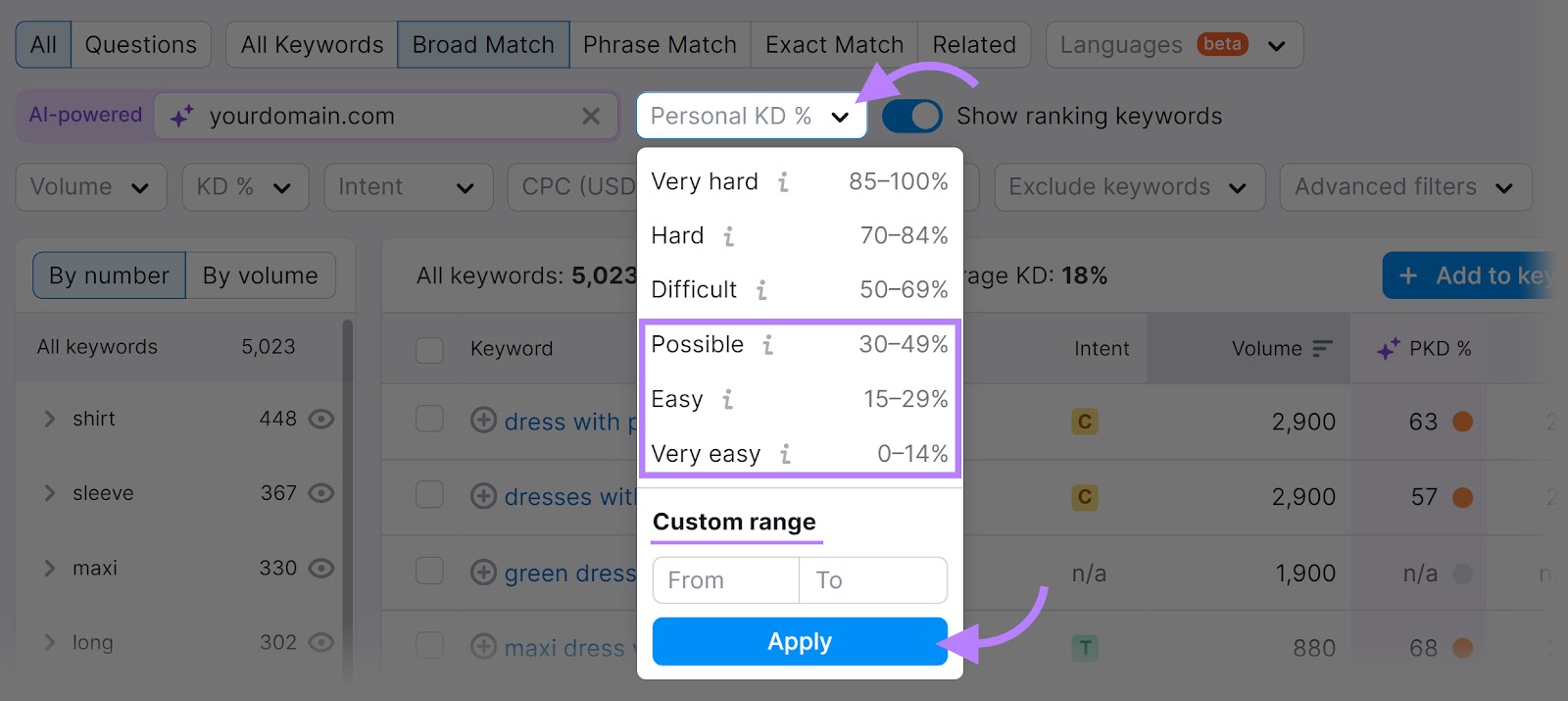
Now you have a much narrower list of low-competition keywords to potentially target.

Select the keywords that align with your goals and products by clicking on the box beside each keyword. Then hit the “+ Add to keyword list” button.
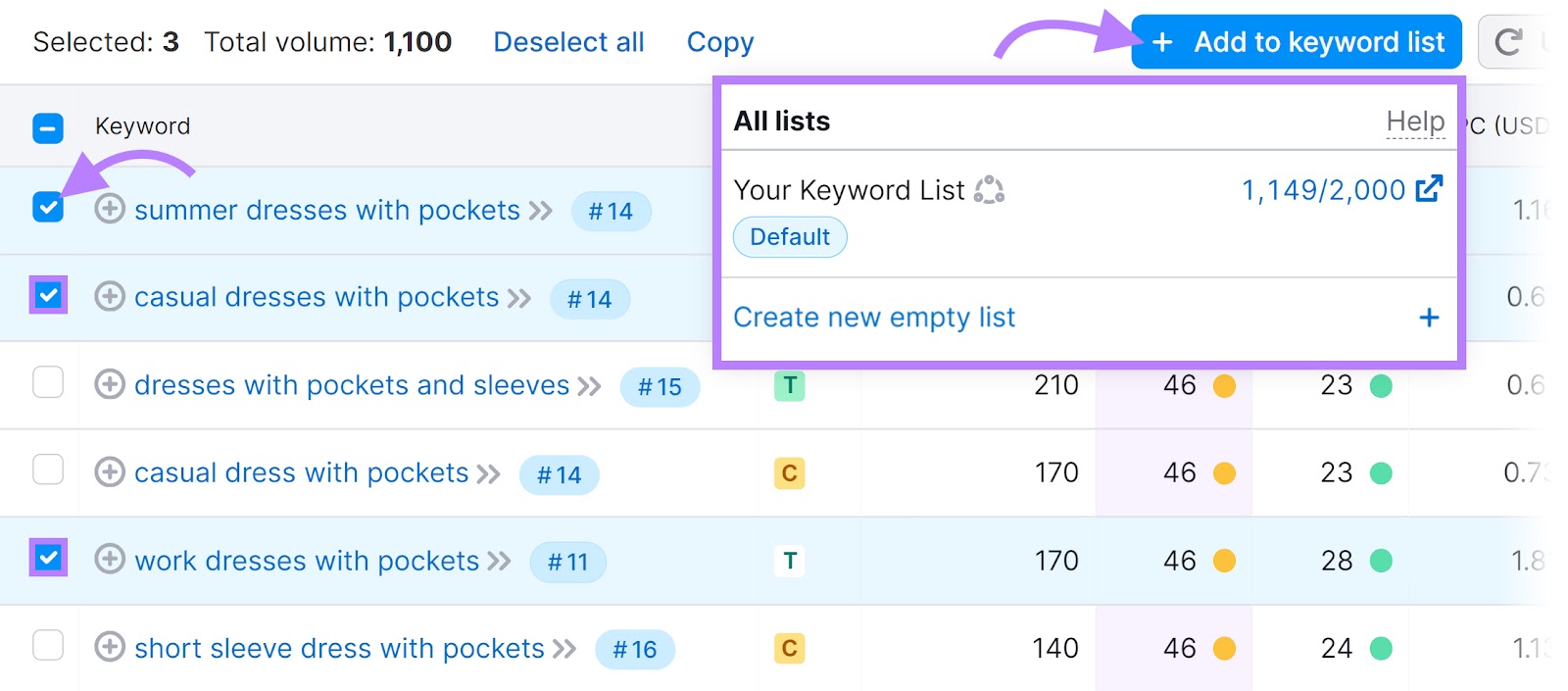
Choose from an existing list. Or click “Create new empty list.”
Once you have chosen your keywords, you will need to craft high-quality content that includes those keywords.
2. Prioritize Meeting Search Intent
Google wants to rank the most relevant and helpful pages for users. So content that is optimized for search intent has a better chance of appearing in the top results.
Search intent (or keyword intent) refers to the underlying purpose or motivation driving a user’s online search queries.
Understanding intent is crucial because it enables you to align your content with what users are seeking.
There are four main types of search intent:
- Navigational: The user is searching for a specific website or webpage (e.g., “Amazon login”)
- Informational: The user is looking for general information on a topic (e.g., “do dresses have pockets”)
- Commercial: The user is researching their options before making the final decision on which product to buy (e.g., “best women’s dresses with pockets”)
- Transactional: The user is searching for a specific product or brand with the intention to make a direct purchase (e.g., “buy dress with pockets Amazon”)
To find out the intent behind a keyword, do a quick Google search.
Take note of the kind of content that is currently ranking. Is it educational “how-to” content and basic “what is” information? Product pages on ecommerce sites? Or a combination of these? This will help you understand what Google thinks the search intent for that keyword is.
Another way (that’s more efficient) to identify search intent is by using Keyword Overview.
Let’s use this tool to search for “casual dress with pockets.”
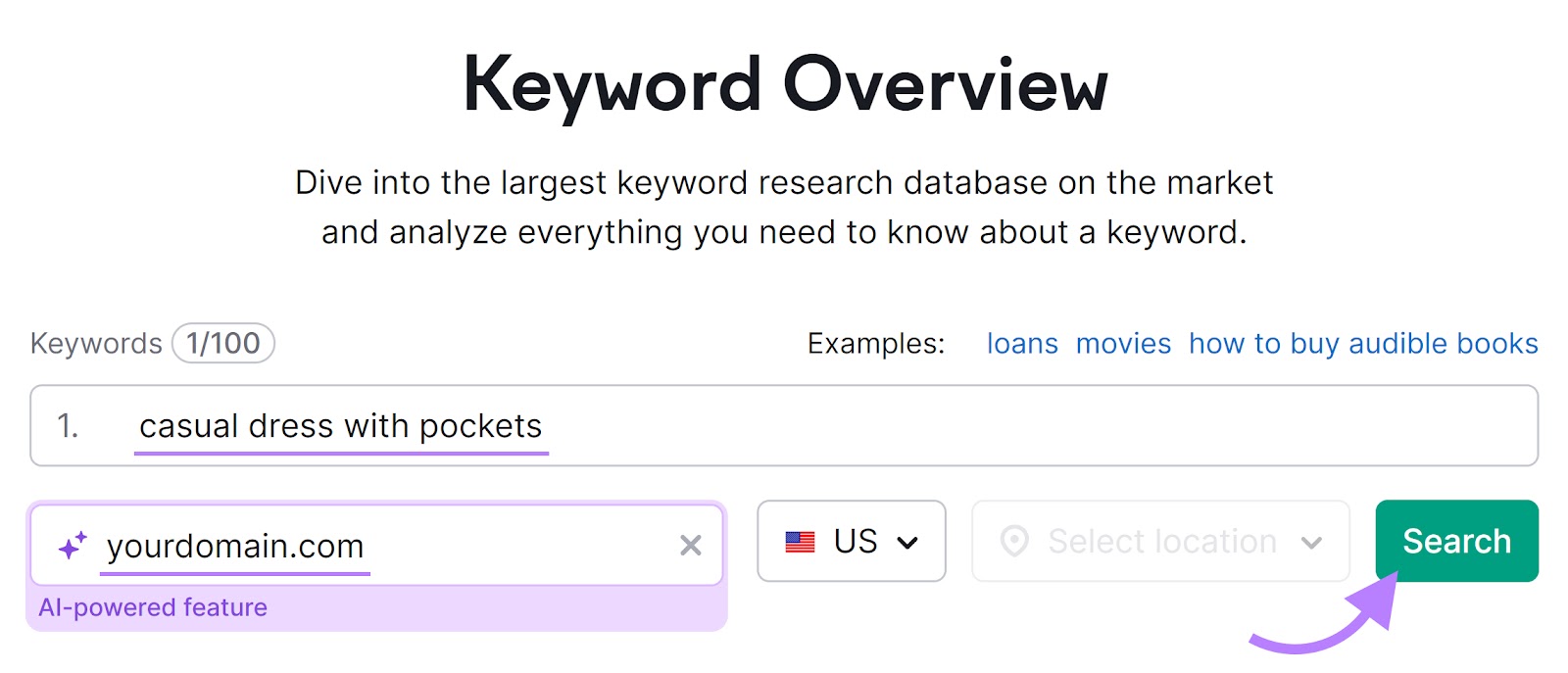
Under “Intent,” you’ll see that the intent for this keyword is commercial.
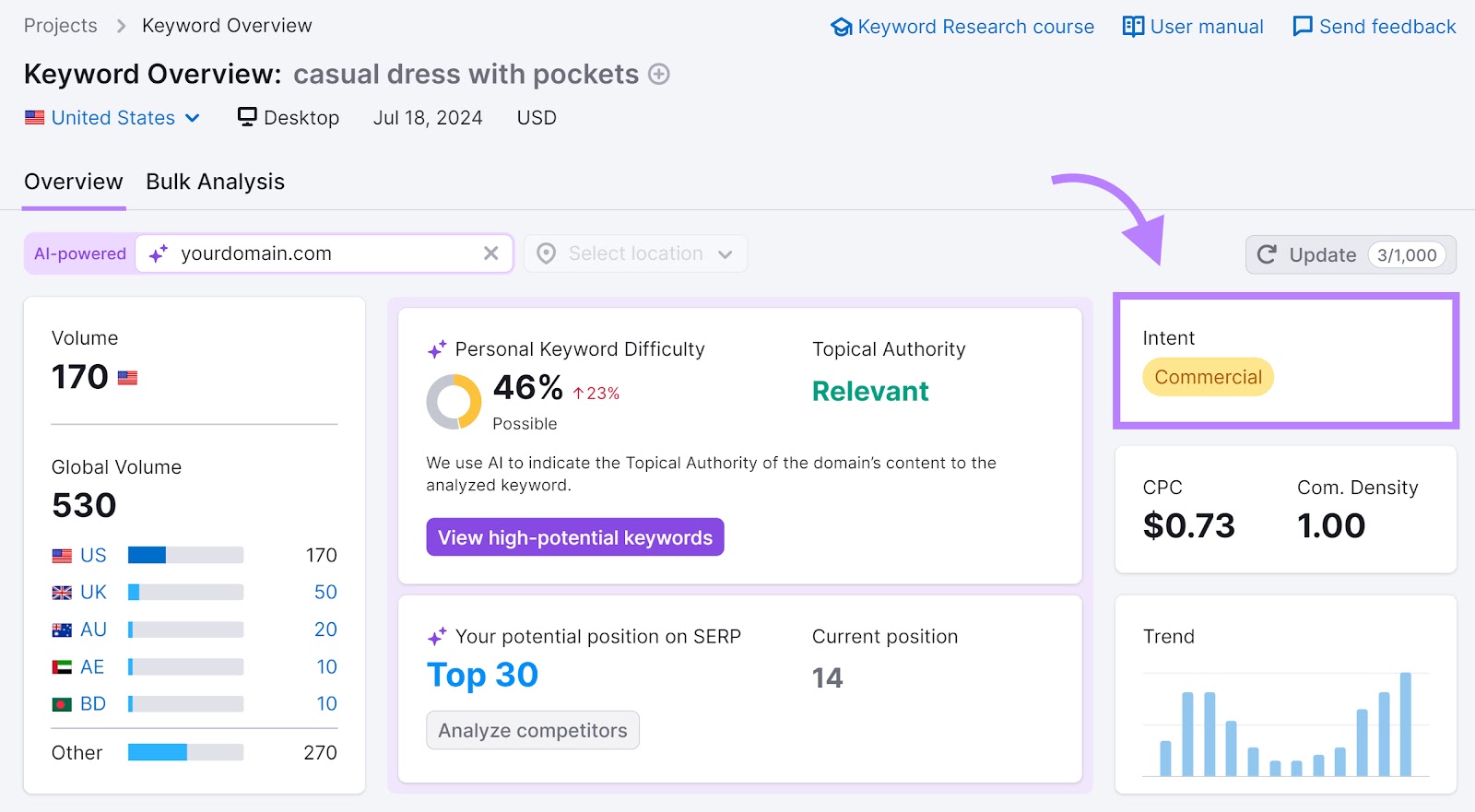
To rank at the top of Google for this keyword, you’ll need to make sure your content meets that intent.
In this case, a category page that features multiple women’s dresses to browse might be helpful. As the user is still in the research phase and not necessarily ready to buy.
If a keyword has informational search intent, blog posts, listicles, or how-to articles that provide answers to their questions are best to create. As they will provide a more satisfying and helpful experience to users who want more information.
Further reading: What is Keyword Intent & How to Align Keywords with User Needs
3. Create Quality Content
The next step is to create high-quality content that is truly helpful. To do that, you need to understand how Google defines those two requirements.
Google has specific guidelines on what constitutes high-quality content that deserves to rank. Those guidelines can be summarized with the acronym E-E-A-T (Experience, Expertise, Authoritativeness, and Trustworthiness).
E-E-A-T is part of Google’s Search Quality Rater Guidelines—the handbook that quality raters (people who work for Google) use to measure the quality of search results.
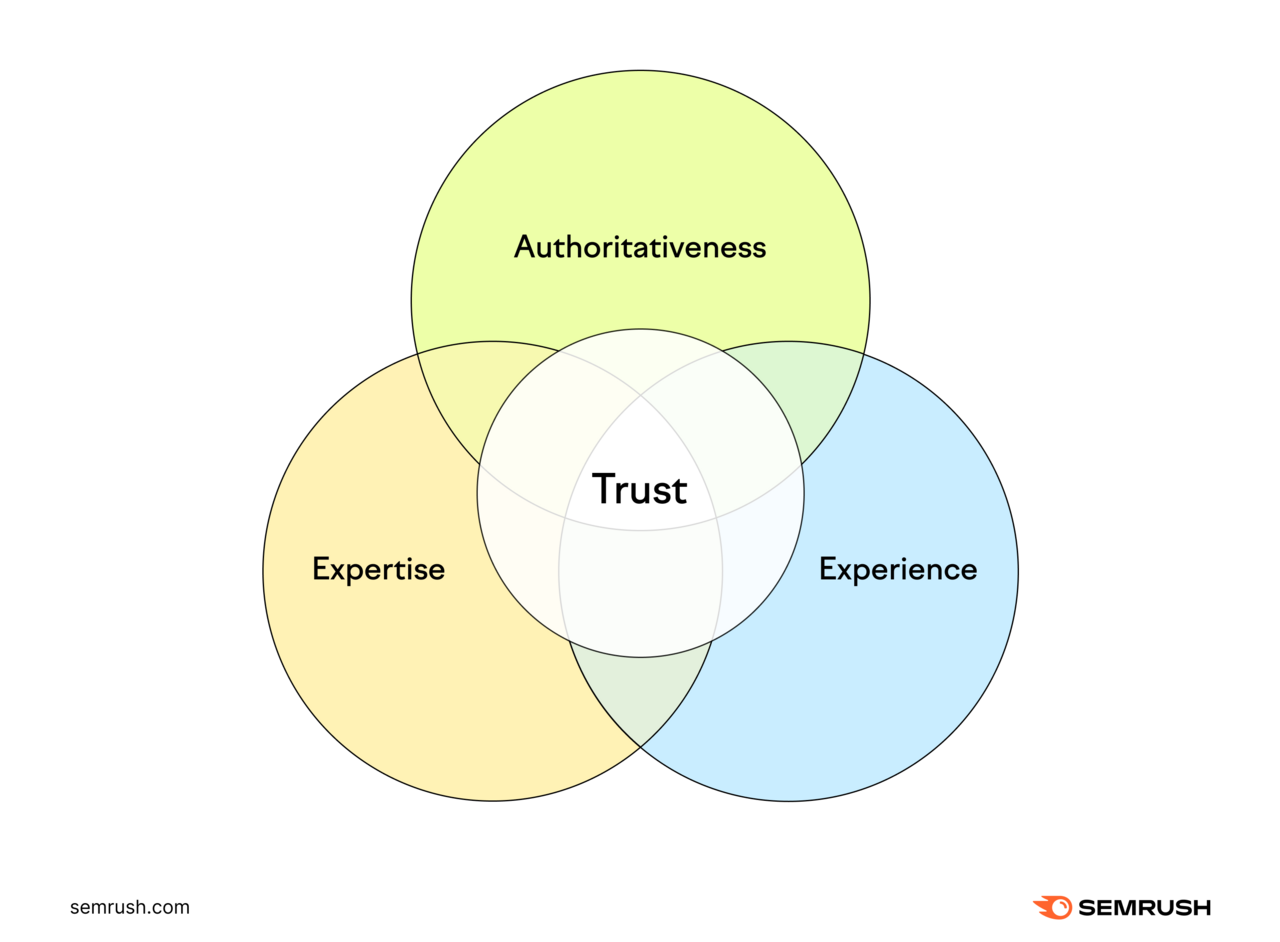
Here’s what each part means:
- Experience: The author has first-hand experience working with the topic
- Expertise: The author is an expert on the topic they are writing about
- Authoritativeness: Your brand has a good overall reputation in your industry
- Trustworthiness: Your content is accurate and cites trustworthy sources (among other factors)
Google’s helpful content update also provides concrete guidance on what helpful, satisfying content looks like.
Content should include:
- Original information, reporting, or research
- A comprehensive overview of a topic
- Substantial value in comparison to other search results
- Correct grammar and spelling
To get started creating quality, helpful content, use the SEO Content Template.
Go back to the list of keywords that you created in step one. Add one of them to Semrush’s SEO Content Template. Then click “Create content template.”

This creates a content brief that provides suggestions to help you rank for that keyword. Like semantically related words, readability, and length.
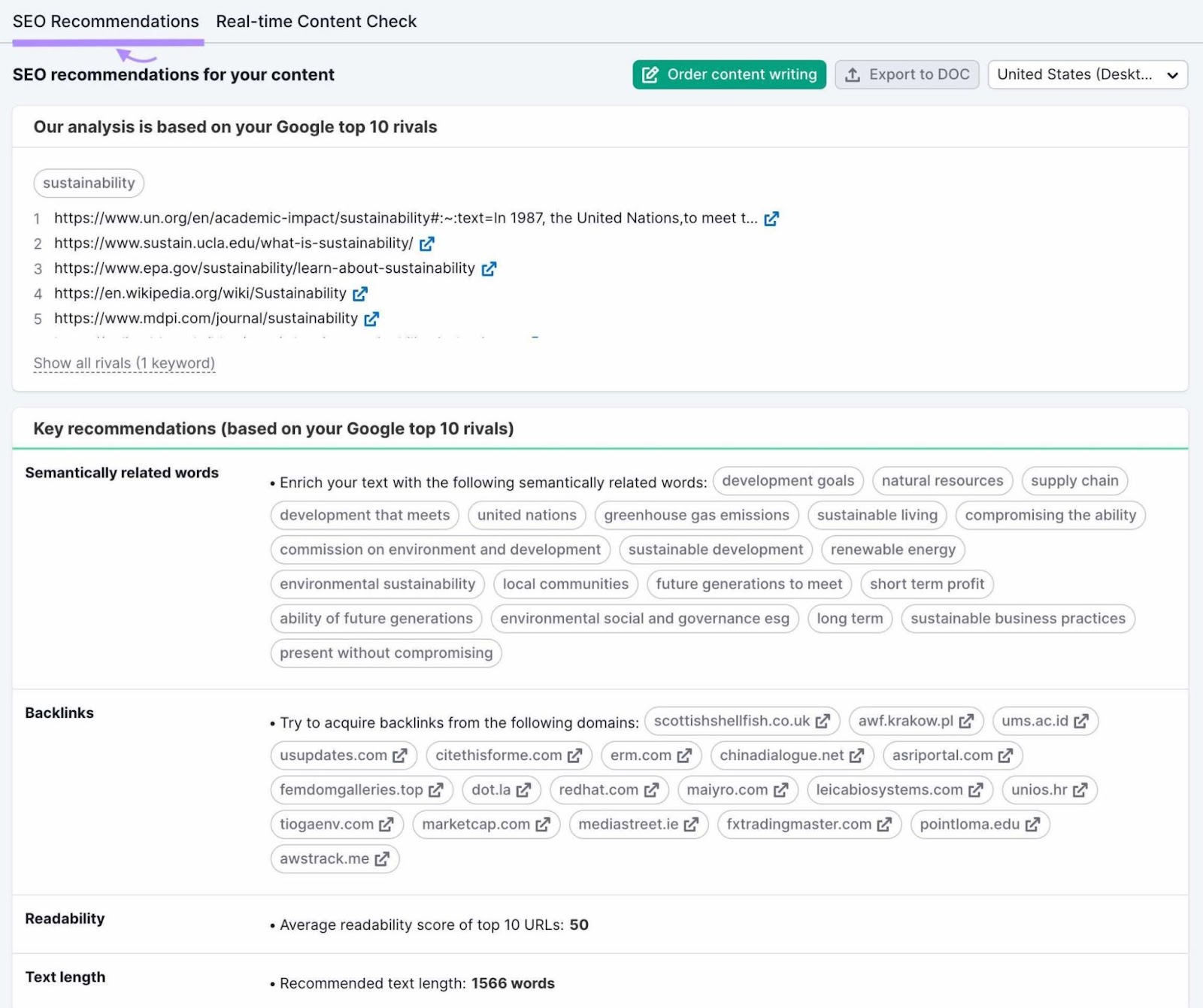
Write your content according to the brief, optimizing your content with the recommended semantic keywords.
When you're done, plug your written content into the SEO Writing Assistant. This tool checks your content for readability, SEO, originality, and tone of voice.
To use this tool, paste in your text, enter the keywords, then click “Get recommendations.”

You’ll receive feedback on the readability and SEO. Aim for a score of 8 or higher.
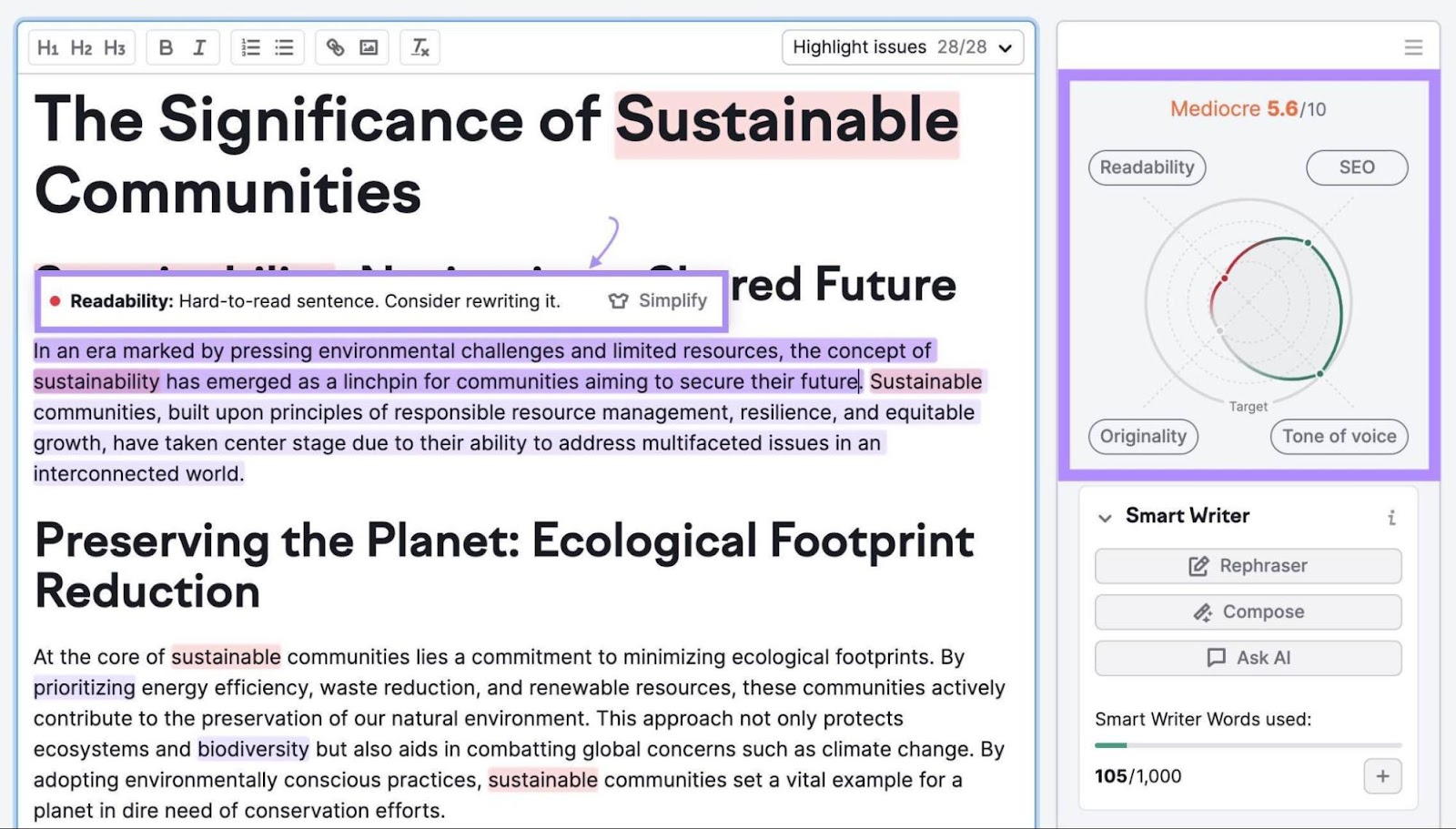
If your score is under an 8, follow the suggestions in the sidebar to improve your content. And use the AI Smart Writer features when it’s helpful to your writing process.
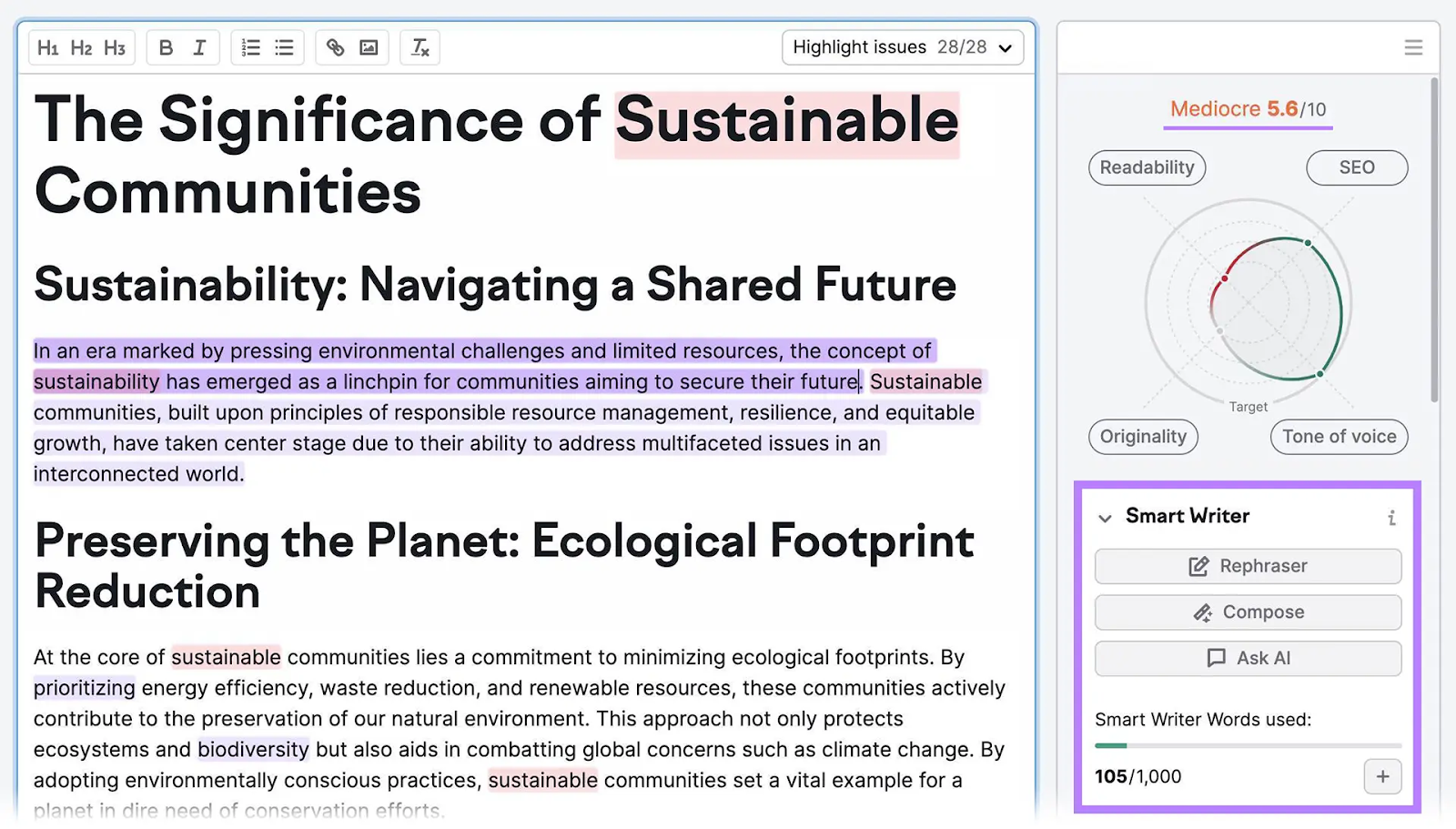
4. Optimize for On-Page SEO
On-page SEO is the process of optimizing the on-page elements of webpages for better rankings. Google uses these elements to determine whether a page matches what a user is looking for.
Here are the most important on-page elements to focus on:
Title Tags
Your title tag describes the main content of your page to your user. Google may use it as the blue, clickable hyperlink of your SERP result.
A clear, compelling title tag improves your chances of ranking. And encourages users to visit your page.
Like this one:

To make your title tags click-worthy and optimize them for SEO, follow these best practices:
- Use one unique title tag for each webpage
- Mention your target keyword in your title
- Stick to under 60 characters
- Avoid generic and vague titles, like “Home” for the homepage
- Include a target keyword
- Make it compelling, but avoid clickbait
Meta Descriptions
Meta descriptions entice users to click through to your page and give them more information about the content. Google may use your meta description beneath your title tag in search results.

To optimize your meta descriptions for better rankings and clicks, do the following:
- Use a unique meta description for each webpage
- Include variations of your keywords
- Stick to under 108 characters (or 680 pixels for mobile)
- Entice your user with click-worthy information (e.g., Free template, Free shipping, etc.)
Heading Tags
Headings give your webpage structure and make it more easy to scan. It also shows Google the various subtopics that are covered on your page.
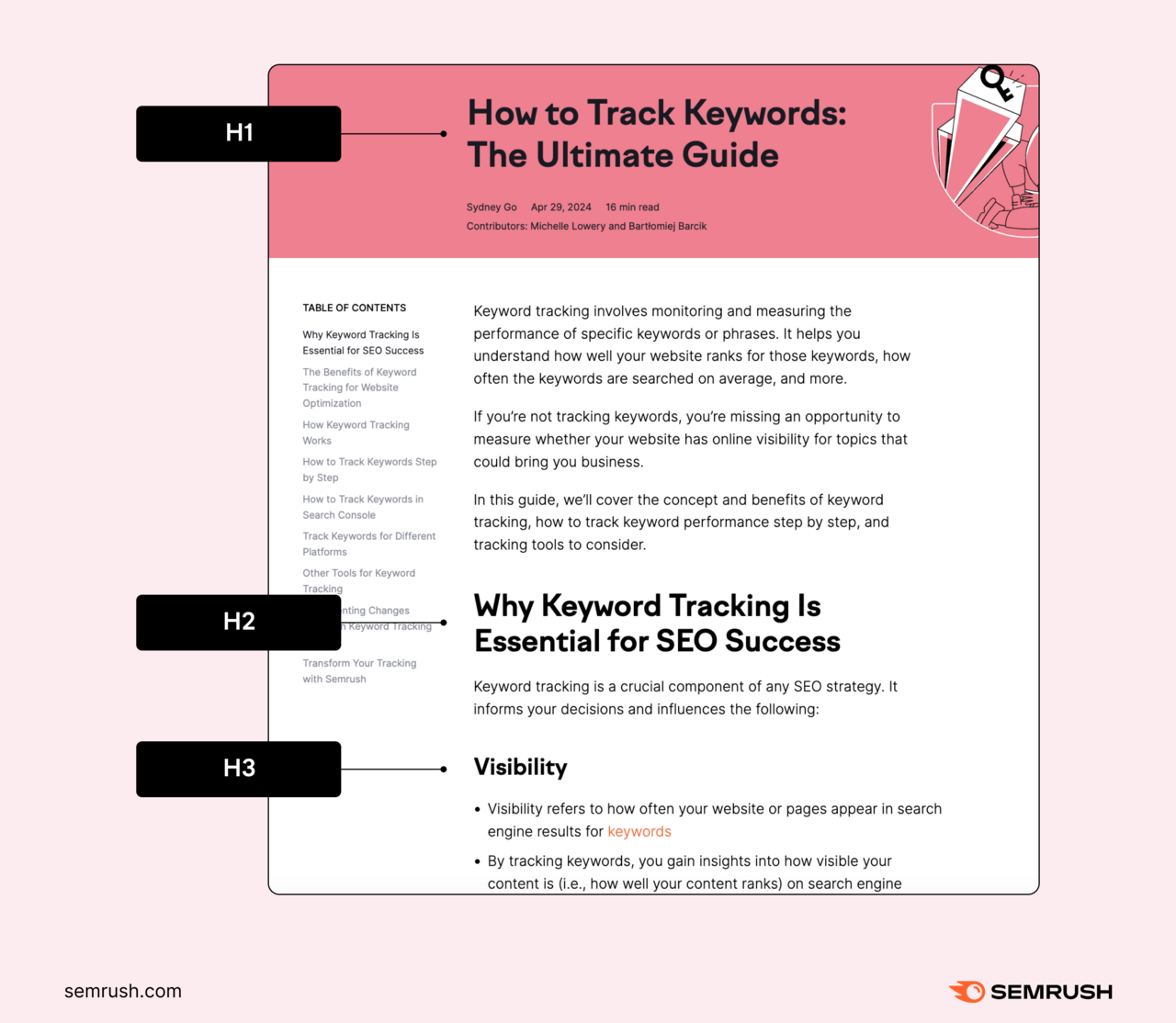
To leverage your headings for better rankings, optimize the following:
- Align heading text with content type
- Only include one H1 tag per page
- Add keyword variations and long-tail keywords into your H1-H3 tags
- Create a logical hierarchy (H2s under your H1, H3s under H2s, and so on)
- Use your heading tags to better optimize for search intent
Multimedia
Engaging multimedia elements like videos and images enhance user experience. As long as they’re optimized for SEO.
Here’s how:
- Ensure all images contain descriptive alt text. This helps ensure they’re accessible to all users, like those who rely on screen readers.
- Compress images for faster loading times. Google prefers faster loading times. And your users won’t wait for your site to load if it takes too long.
- Choose file names for your images that include valuable information relevant to the image’s content. This can help search engines understand and index your visuals effectively.
5. Use Internal Links
Internal links guide users to related content within your site, providing more value and encouraging them to explore further.
Search engines also use these links to understand the structure of your site and the relationships between pages.

So review your blog articles, product pages, and other important content. To see where you have opportunities to link to related content on your site.
Then, make sure you link to pages that are contextually relevant. It’s also a good idea to prioritize pages with valuable information that need a traffic boost.
A strong internal linking strategy can lead to Google discovering more of your webpages. And building topical authority signals that show your website has a large amount of helpful content.
To check your internal linking (and other on-page elements listed above), use the Semrush On Page SEO Checker.
Enter your domain. Then, click “Get ideas.”

Select your target location and click “Continue.”
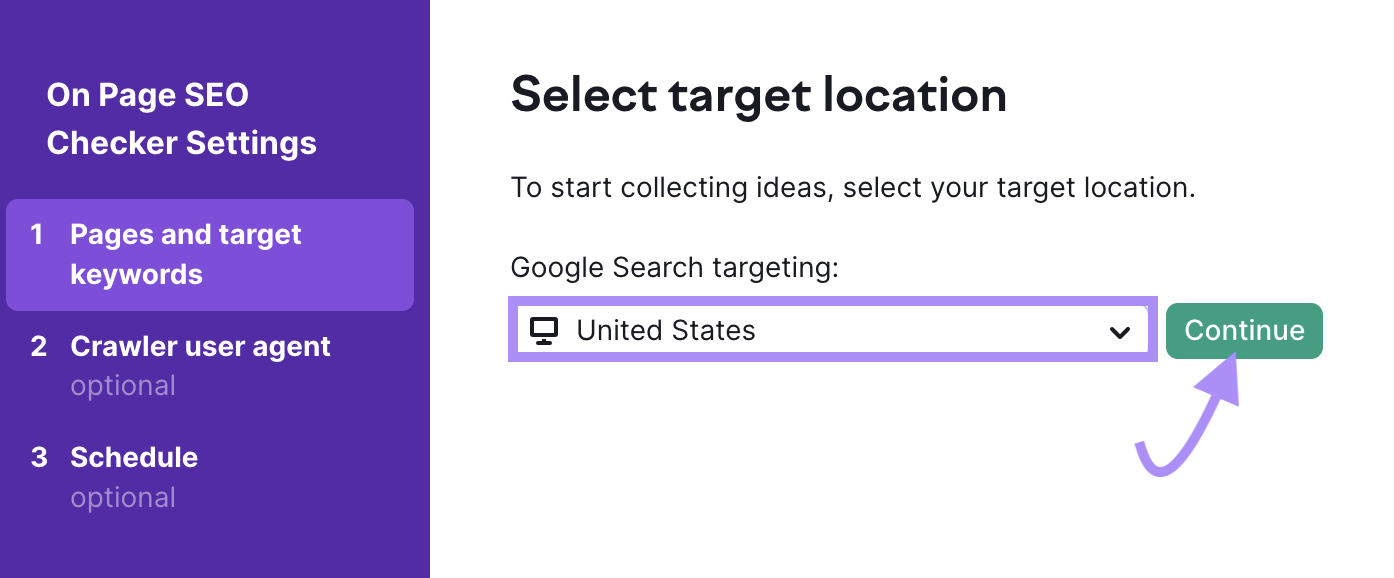
Add the pages you want to analyze. Then click “Collect ideas.”
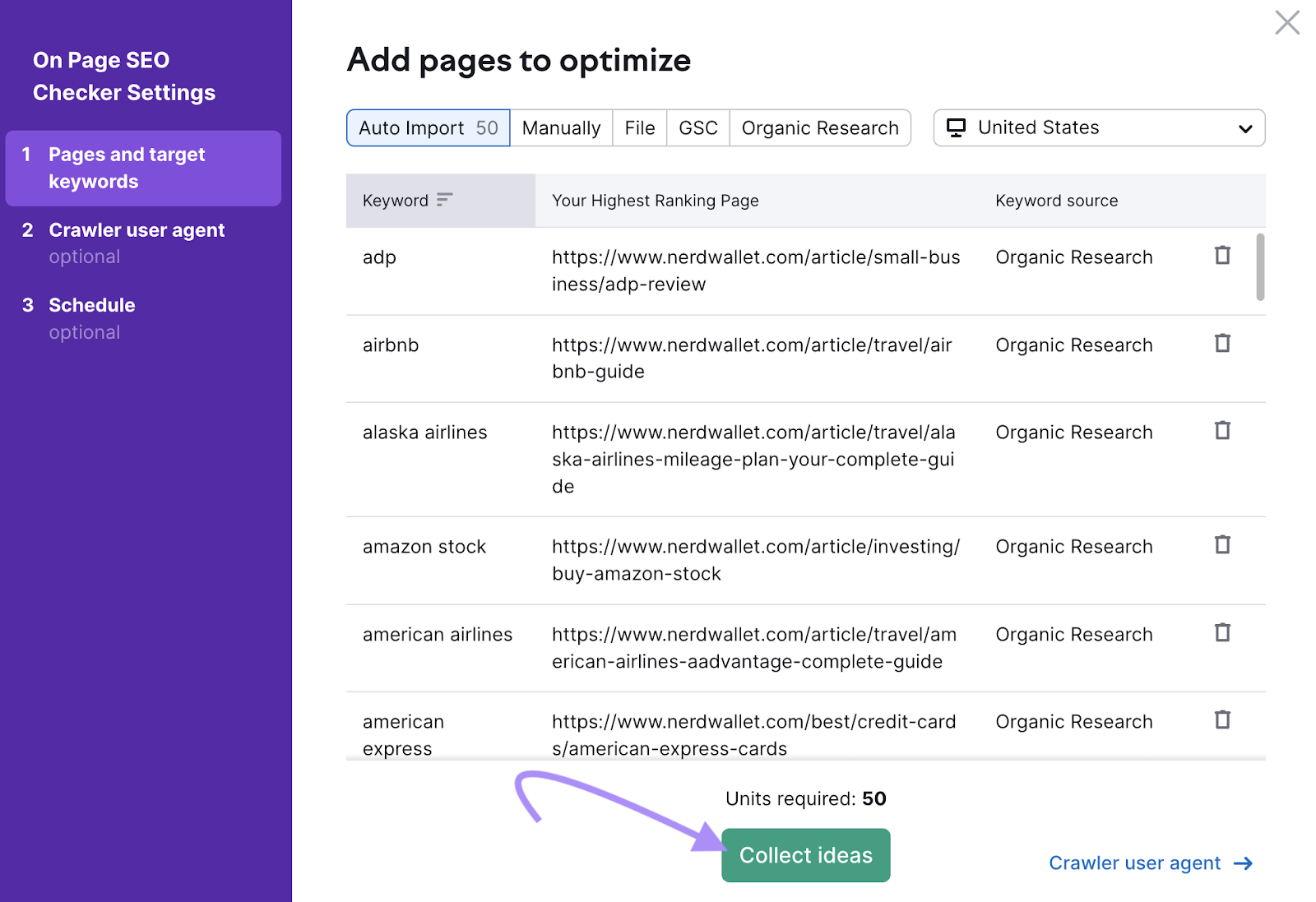
You will find ideas on how to optimize your pages. And a list of the top pages to optimize.
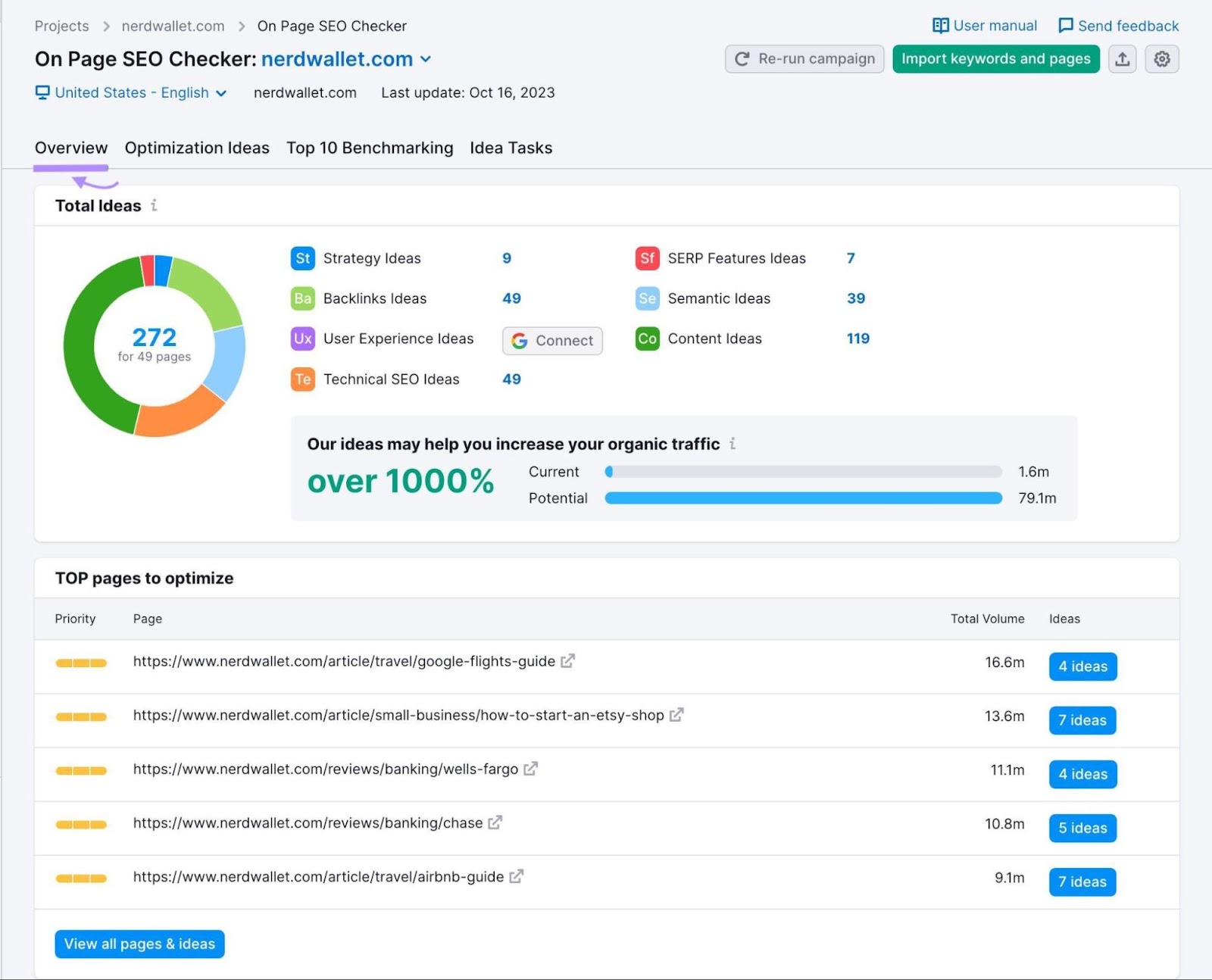
6. Get Backlinks
Backlinks are links on other websites that point to your site. For search engines, they serve as digital votes of confidence that your website is credible and trustworthy.
When reputable websites link to your content, Google may view these endorsements as a signal that your content is valuable and worth showing to users.
People often link to content they find valuable. So, if you create lots of high-quality content, you may have an easier time getting backlinks.
Here are some types of content that can be very link-worthy:
- Expert takes
- Case studies
- White papers and reports
- Surveys
- Infographics
As long as your content is a great resource, you can get backlinks organically. But the process can be slow, especially if you’re just starting out
Here’s how you can actively seek backlinks from websites.
Head to Semrush’s Link Building Tool to find potential sites that may be willing to link to your website.
To get started, enter your domain and click “Start Link Building.”
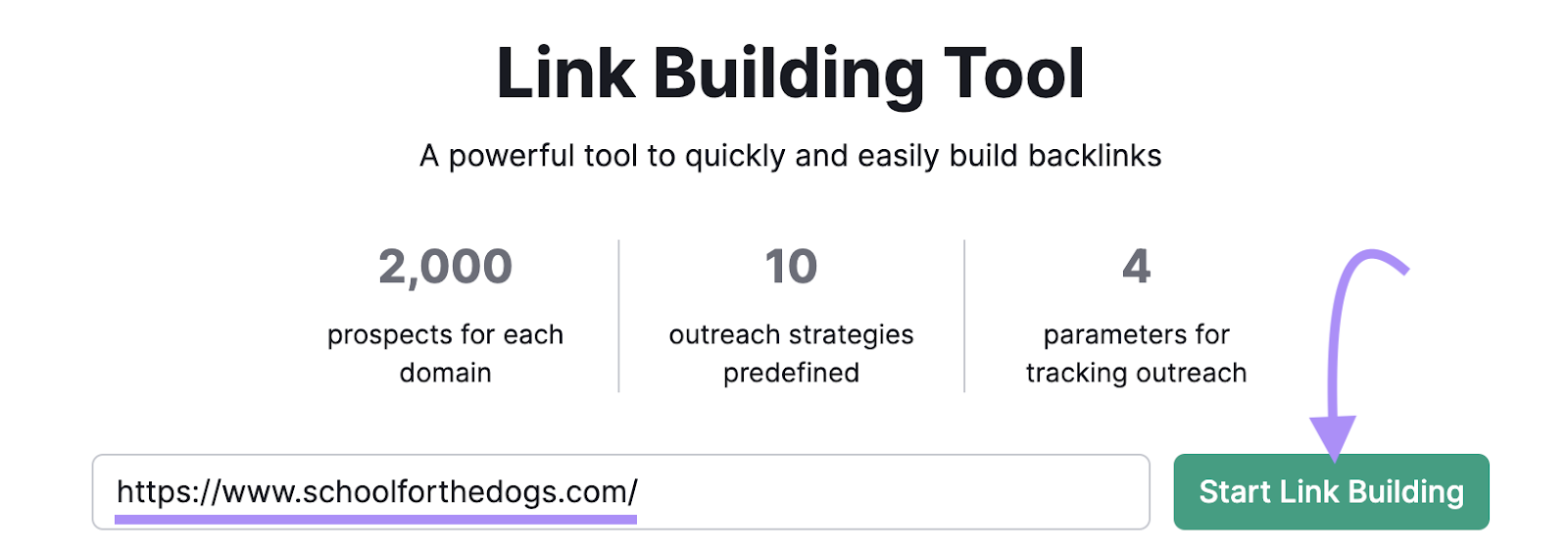
Then, add relevant keywords connected with the content you want to rank for.
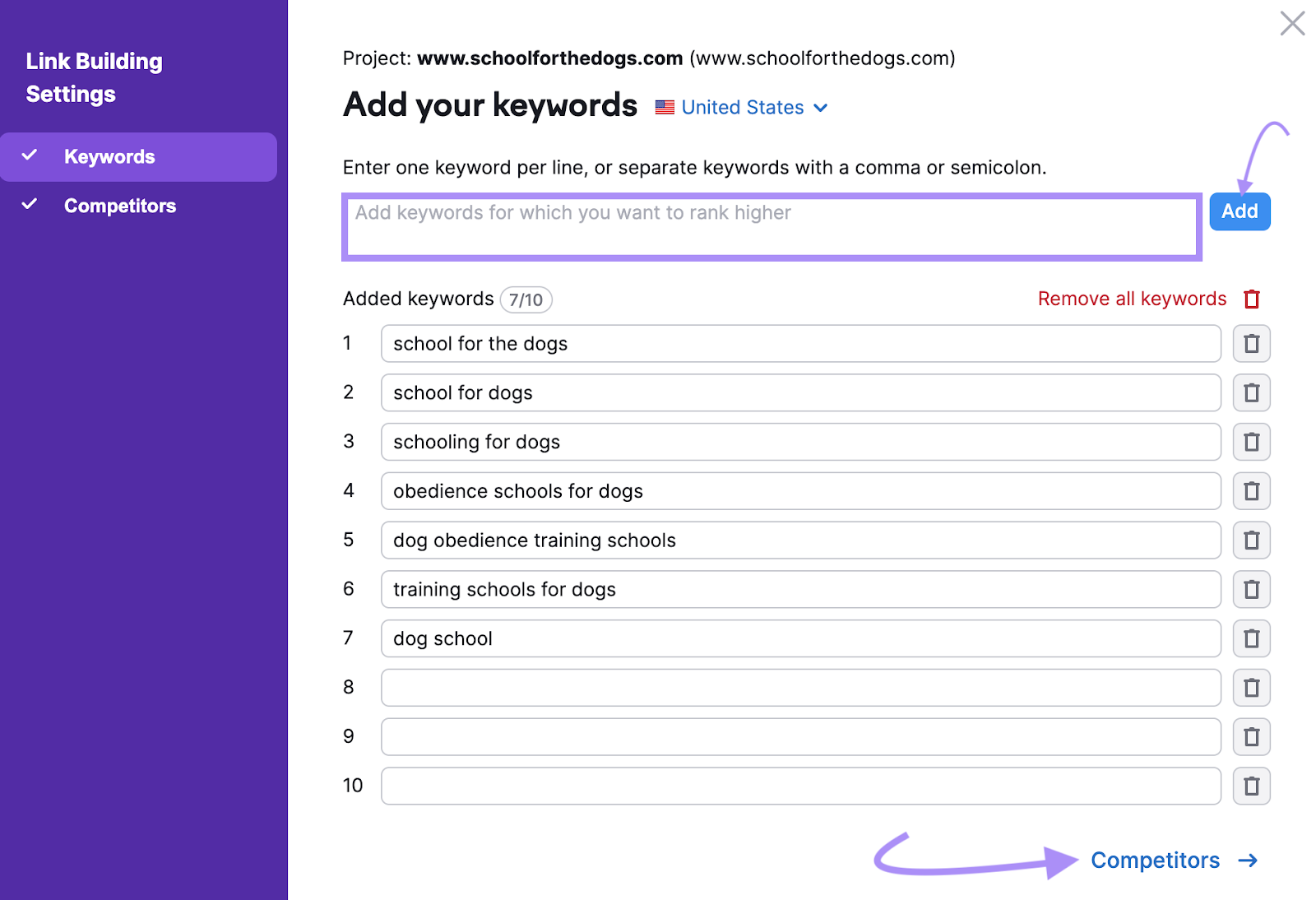
After you add keywords, click “Competitors” at the bottom of the screen.

Add the competitors you want to outrank. Or proceed with the competitors automatically suggested by Semrush.
Then, click “Start Link Building.”
The tool will take a minute or so to collect and analyze the data. Then, you’ll see a confirmation pop-up showing how many prospects it found. To view the results, click “View prospects.”

You’ll find a list of websites you could reach out to for backlinks:
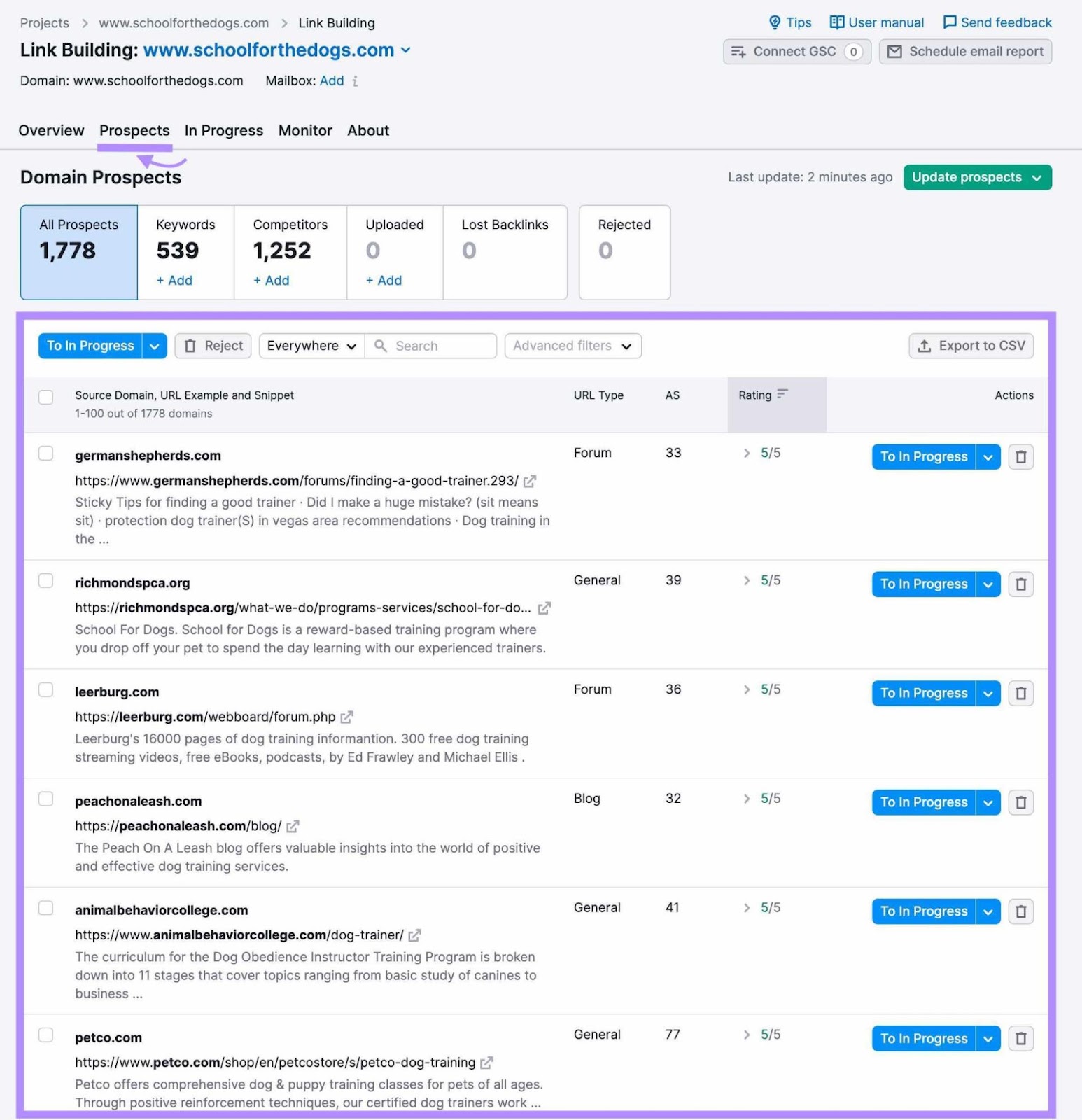
For guidance on how to reach out, check out our full guide to link building.
7. Make Your Site Mobile-Friendly
Google uses mobile-first indexing. That means Google will use the mobile version of your site for indexing and ranking.
So, if you want to get to the top of Google, your mobile pages must be properly optimized.
To check if your site is optimized for mobile SEO, check on the “Mobile Usability” report in your Google Search Console account.
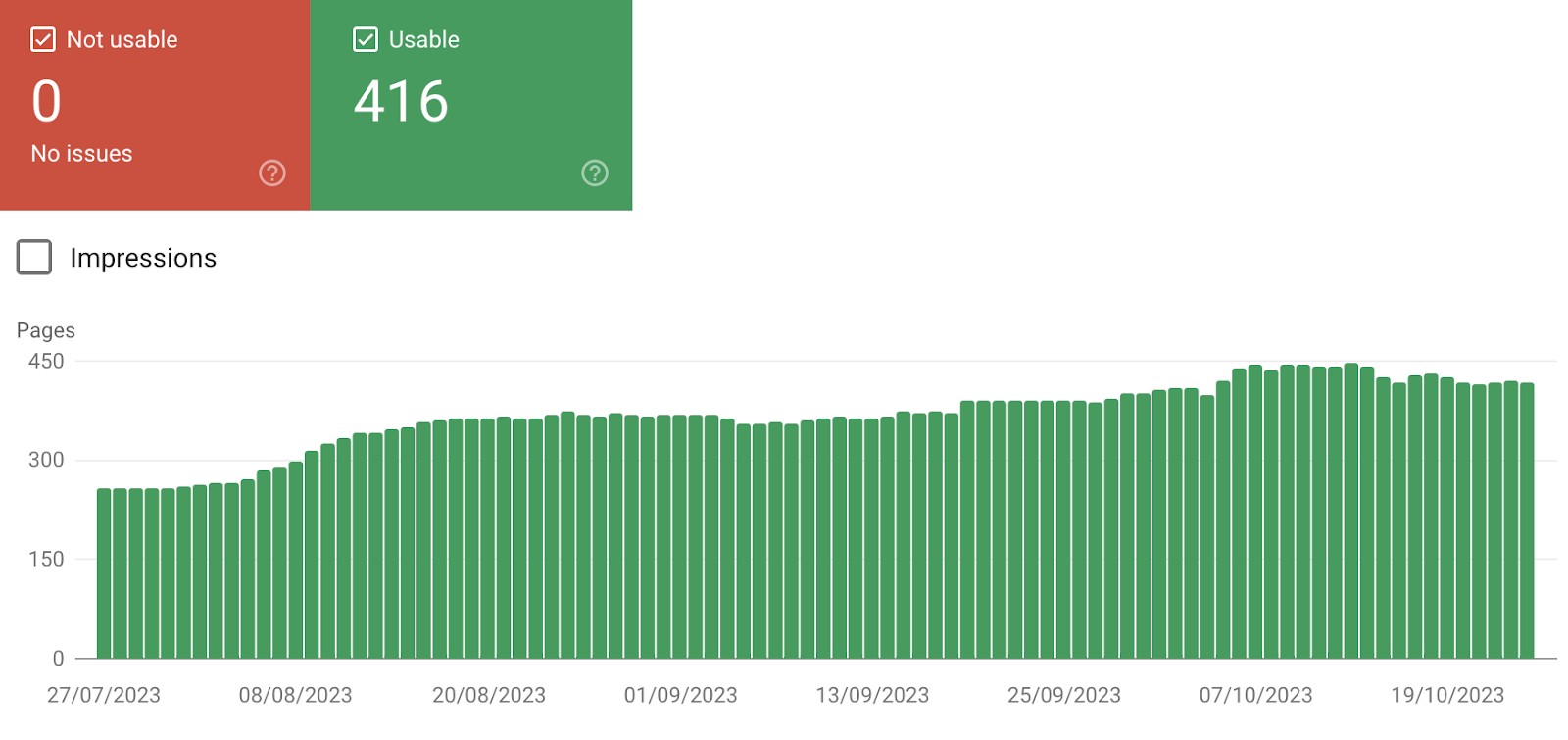
The report shows you the number of pages with poor mobile usability. It also lists the specific issues, so you know what to improve.
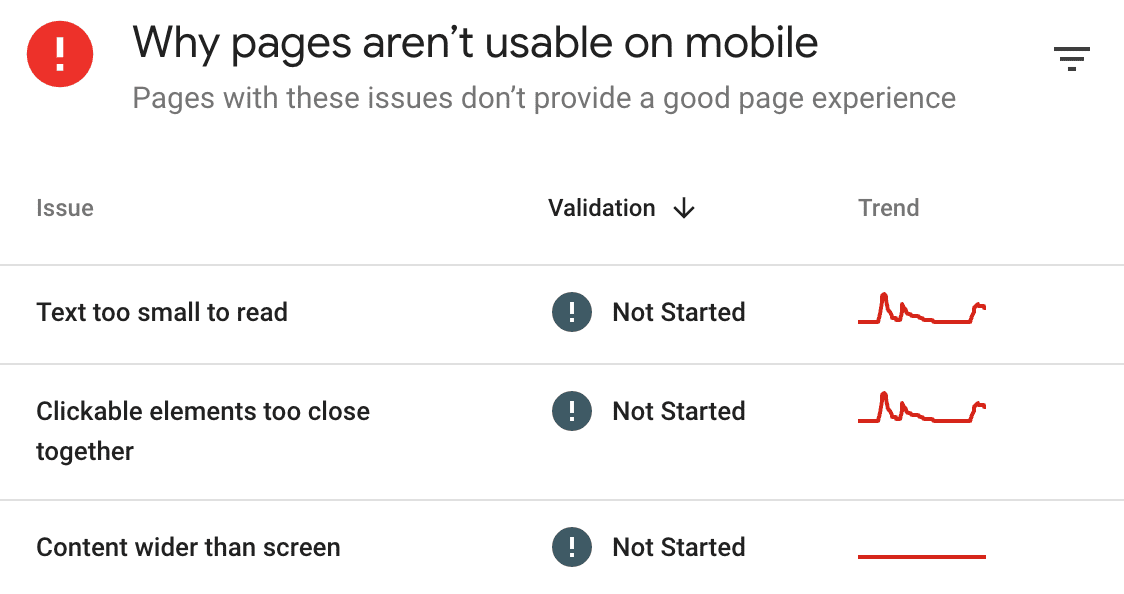
Need help optimizing your site for SEO? Check out our complete guide to mobile SEO.
8. Prioritize Fast Loading Times
Users and search engines like pages that load quickly. Slow-loading pages frustrate users. And if a website loads faster, search engines can crawl it faster.
To check how fast your site loads, use the Semrush Site Audit tool.
Just enter your site in the search bar, and click “Start Audit.”

Then, choose the number of pages and crawl the source. Click “Start Site Audit.”
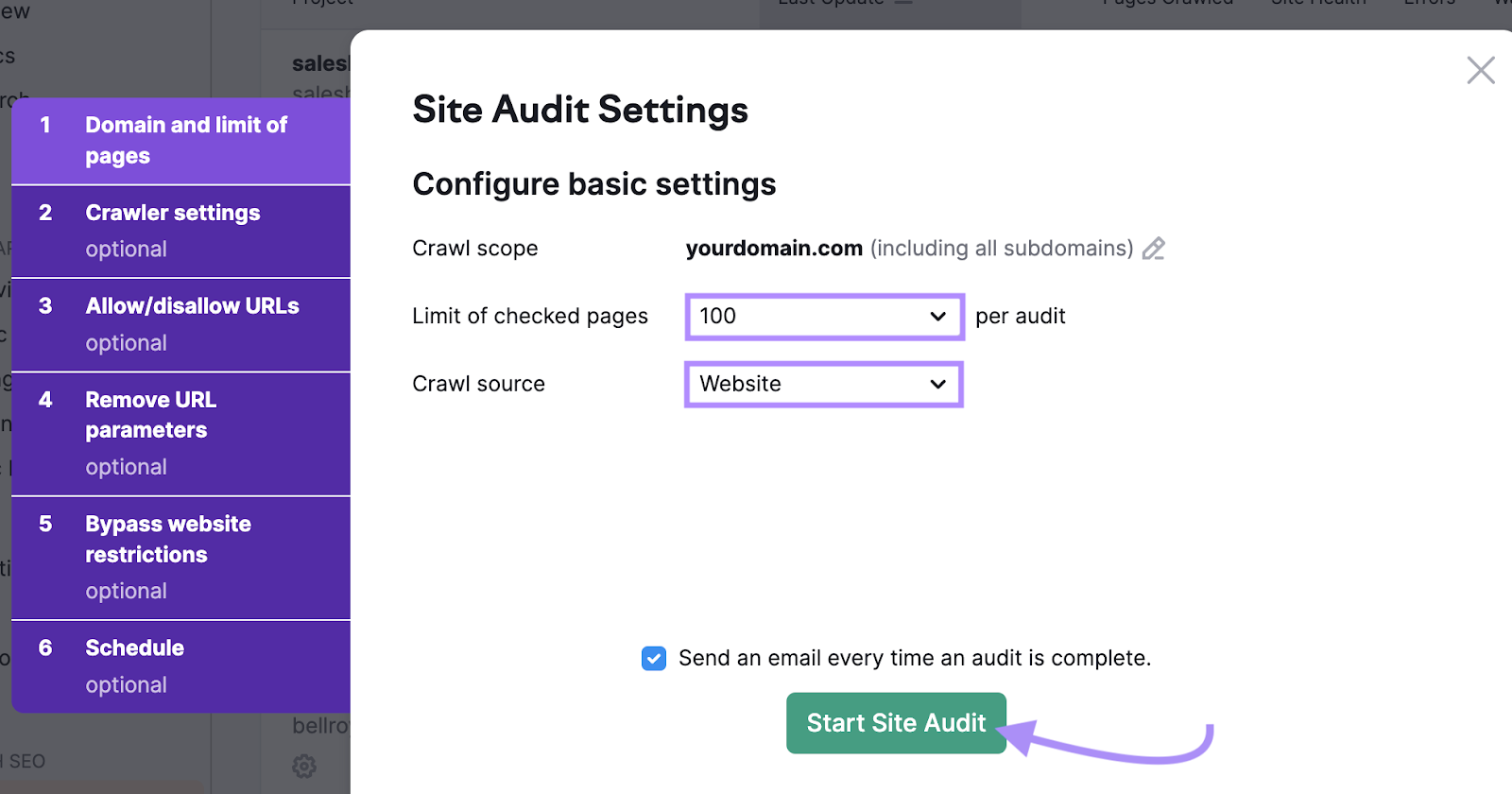
You’ll see a dashboard like this one. Click on the “View details” button under “Site Performance.”
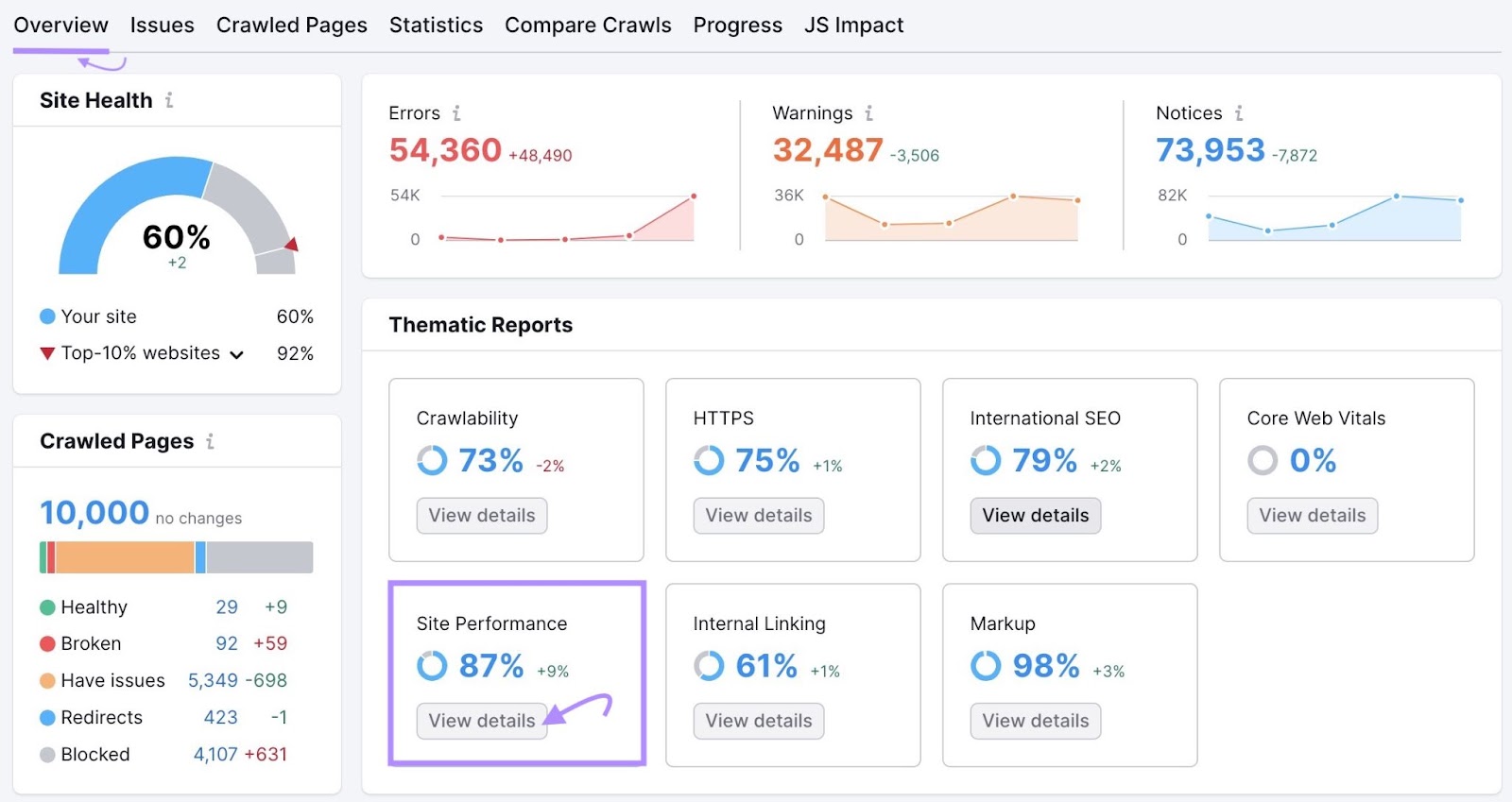
Within the “Site Performance” report, you can find your average page load speed in seconds.
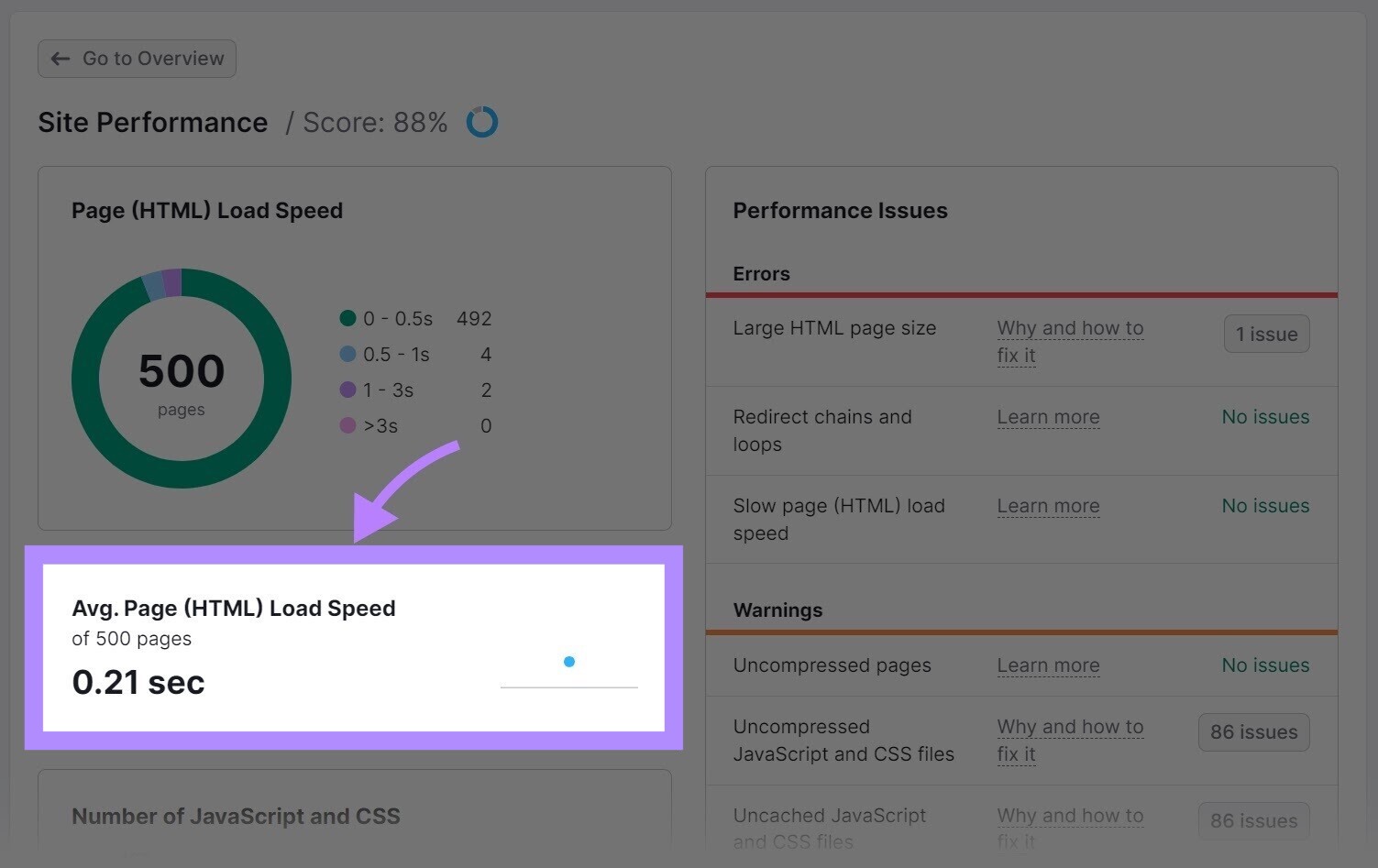
In general, you’ll want to aim for a page load speed of less than three seconds. The faster, the better.
There are many things you can do to make your site faster. To get ideas and step-by-step instructions, take a look at our guide to page speed.
9. Fix Any Technical Issues
Technical SEO involves optimizing technical factors that impact the crawling, indexing, and ranking of your website.
If Google can’t find or read your page content, it won’t show your pages in search results.
So, if your pages don’t seem to be ranking even after you’ve optimized them for SEO, then you might have a technical issue.
To find that technical issue, run your website through Semrush’s Site Audit tool.
You’ll get a set of percentage scores and “Thematic Reports” for different categories. As you resolve issues on your site, these numbers should improve.
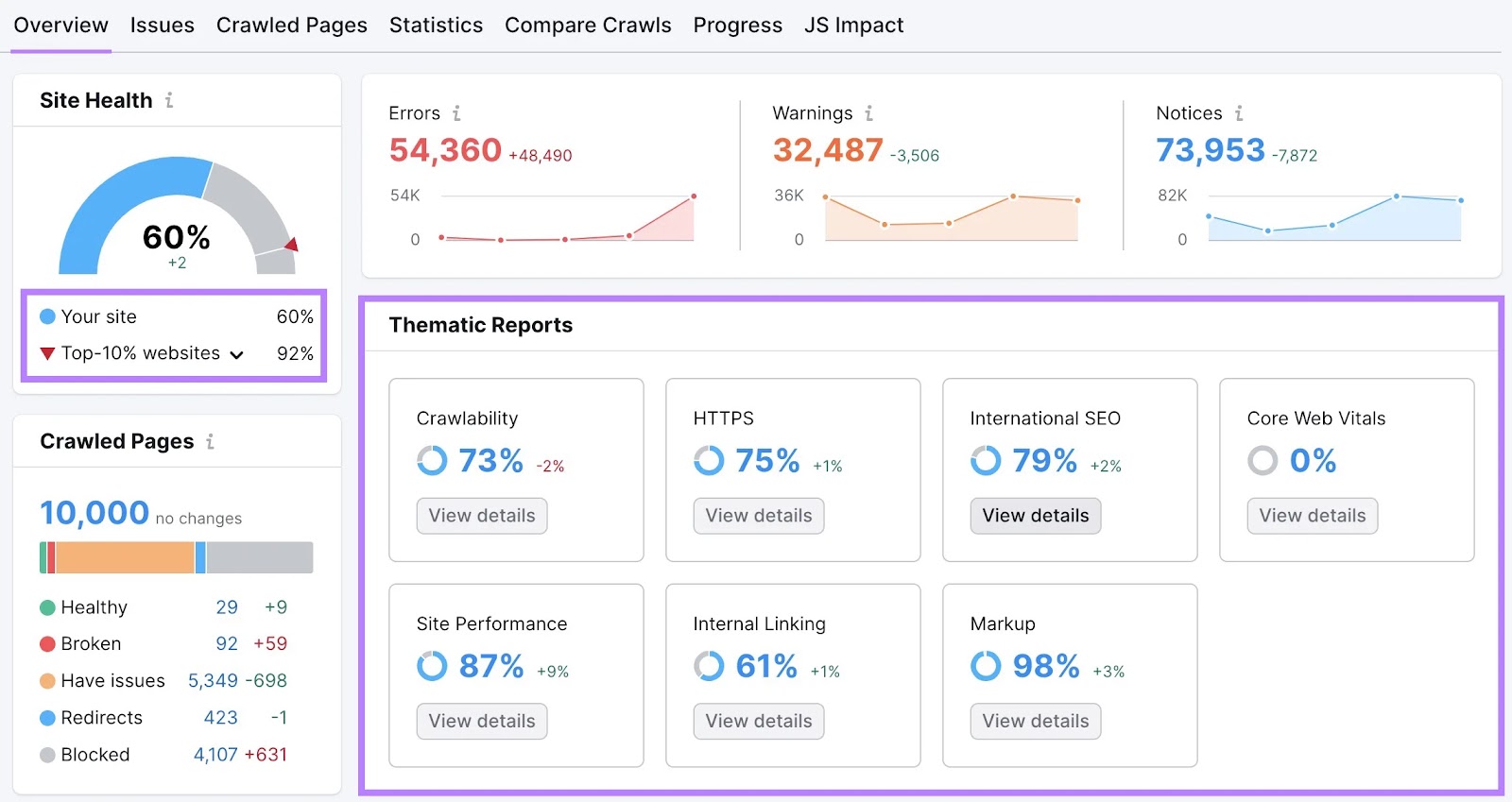
To find what to fix, go to the “Issues” tab.

It will show you a list of the errors found on your site. And call out any pages that can’t be crawled.
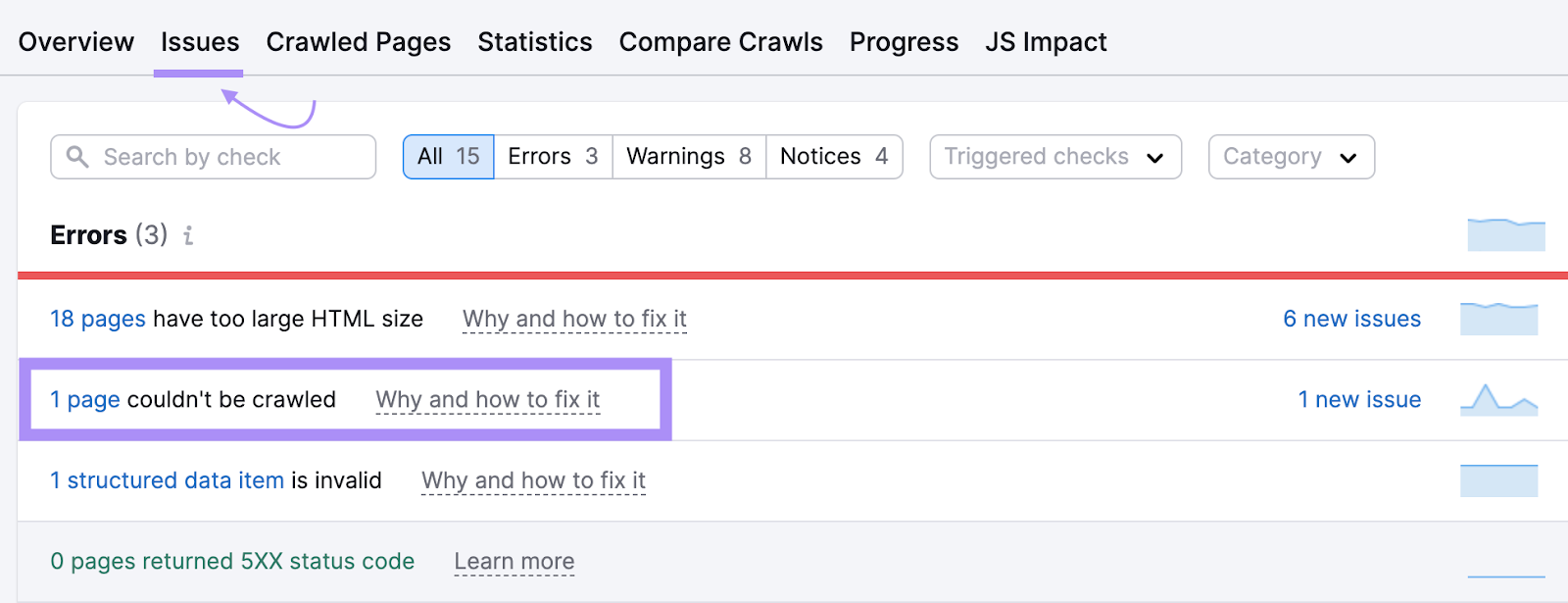
You can take this report to your website developer or IT team. Or conduct further research to fix the issues yourself.
10. Improve Your Local SEO
If you own a business with a physical location, or that serves a specific geographic area, you’ll want to rank for searches related to that area.
That’s where local SEO comes in. Local SEO is all about ranking for those users who are searching for services in your regional area. Like:
- “Pizza near me”
- “Dallas hairdressers”
- “Coffee shops in Denver”
Ranking for local searches can be a big advantage for local businesses wanting to increase appointments, phone calls, and foot traffic. Because they appear right at the top of the search results page.
Like this:
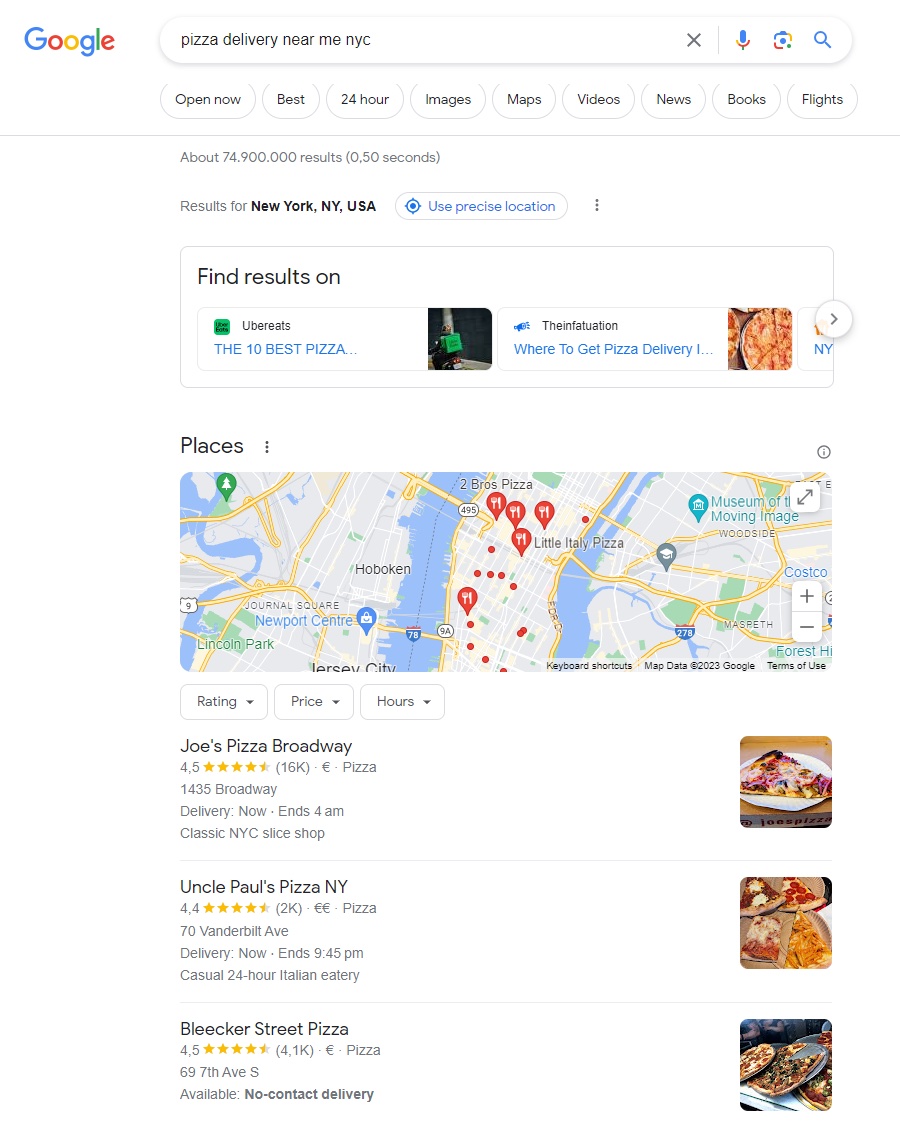
For mobile users, top-ranking mobile results also provide the option to call or get directions immediately.
In addition to Google’s usual ranking factors, its local search algorithms use three main factors to decide which pages to rank:
- Relevance: How closely related a Google Business Profile result is to what a user is searching for
- Distance: How geographically close the business is to the user
- Prominence: How reputable Google thinks a business is
Many of the strategies outlined earlier in this article can help you increase these signals. But another impactful strategy is to build local citations.
Local citations are mentions of your business information on third-party websites (e.g., Yelp, Angie’s List, Thumbtack, etc.)
Google promotes your site by looking for consistent information across your business listings (like phone number and address).
Focus on third-party websites that are important to your industry. Then, use Listing Management to upload your business info into multiple directories simultaneously.
Keep Tracking Your SEO Performance
Once you’ve created and optimized your content, it’s essential to track the results. So you can measure the impact and identify areas for improvement.
One way to do that is with Google Analytics. You can check to see if your organic search traffic has changed for the pages you optimized.
Open Google Analytics. In the menu on the left, click “Acquisition” and then “Traffic Acquisition.” You’ll see the number of users and sessions from organic search. You can change the time frame to see the development over time.
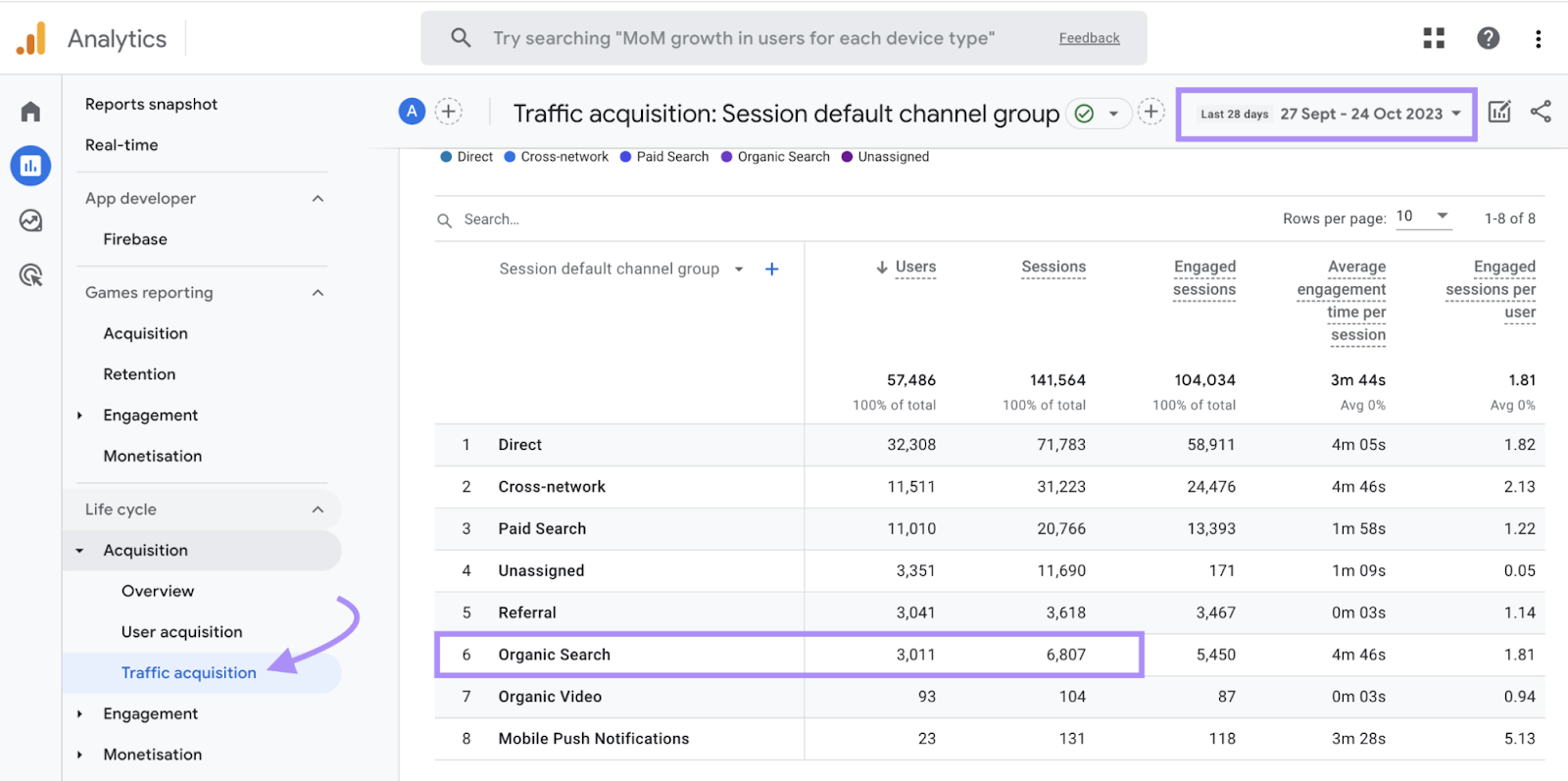
Google Analytics will tell you how much traffic you get from organic searches.
Then, track your SEO rankings with the Position Tracking tool.
Simply enter your domain and click “Set up tracking.”

Then, select your targeting settings. Including search engine, device, location, and your business name. Then click “Continue to Keywords.”
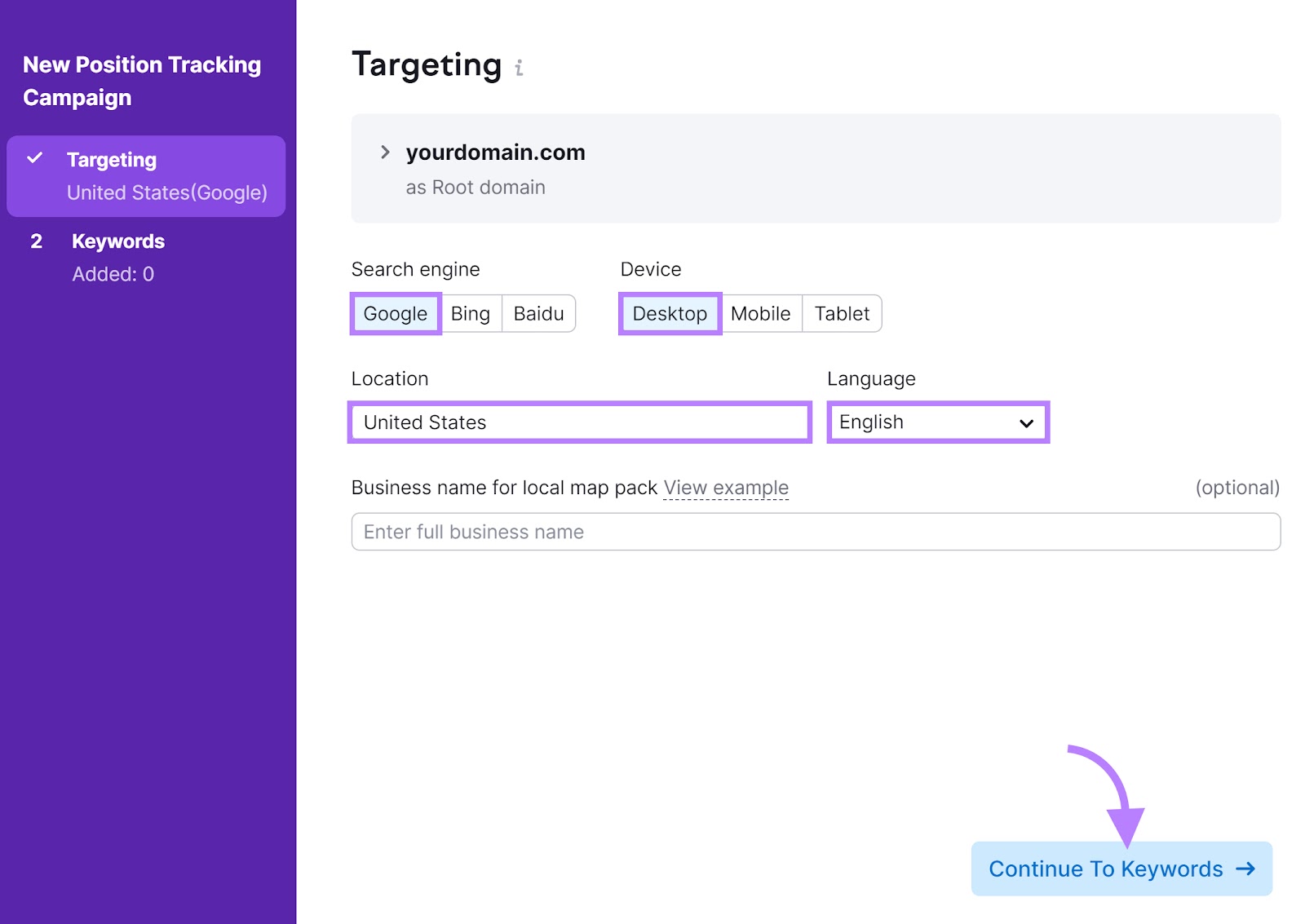
Then enter the keywords you want to track positions for. When you’re finished, click “Start Tracking.”
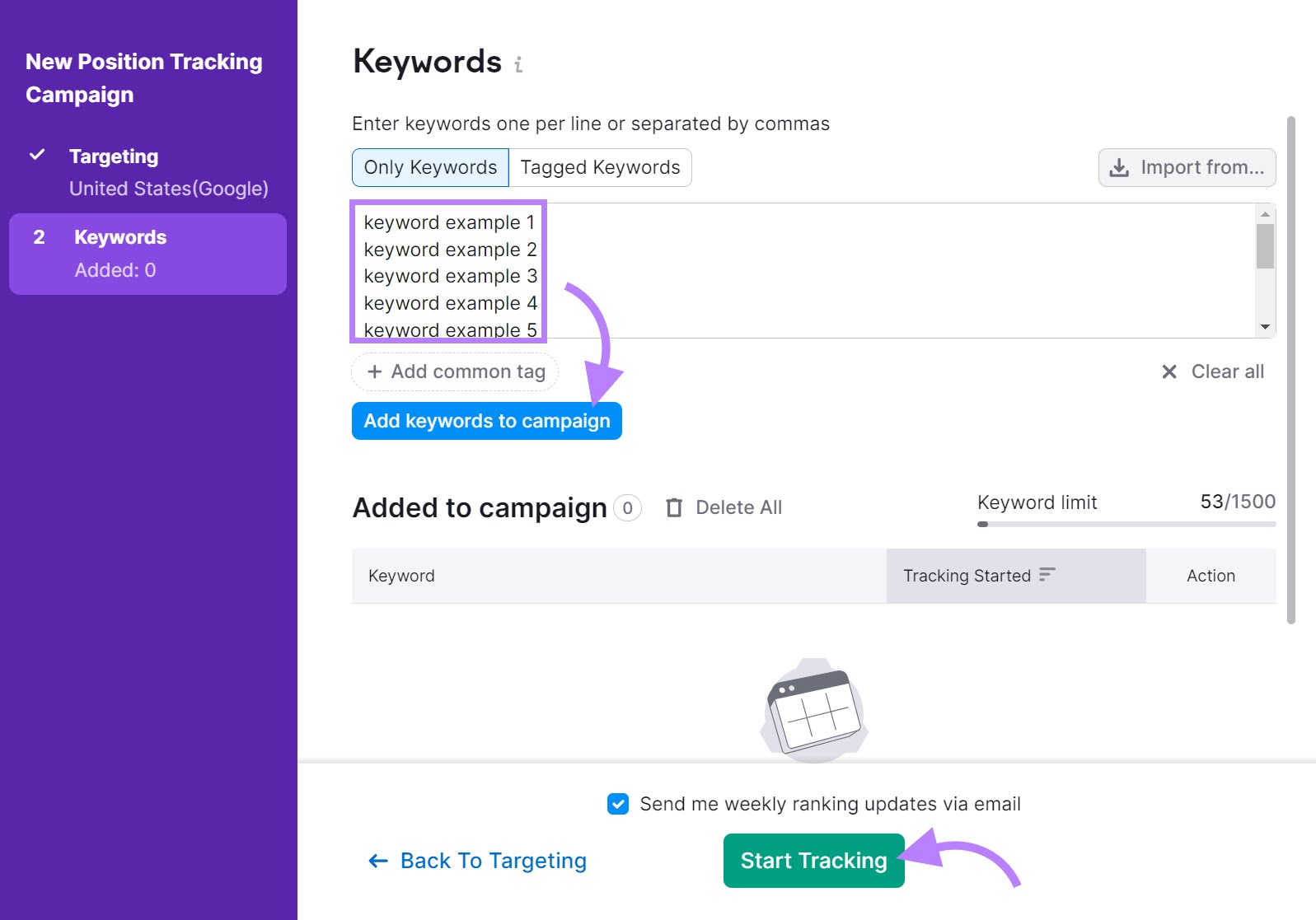
The report provides insight into how well different pages of your site are ranking for your target keywords.
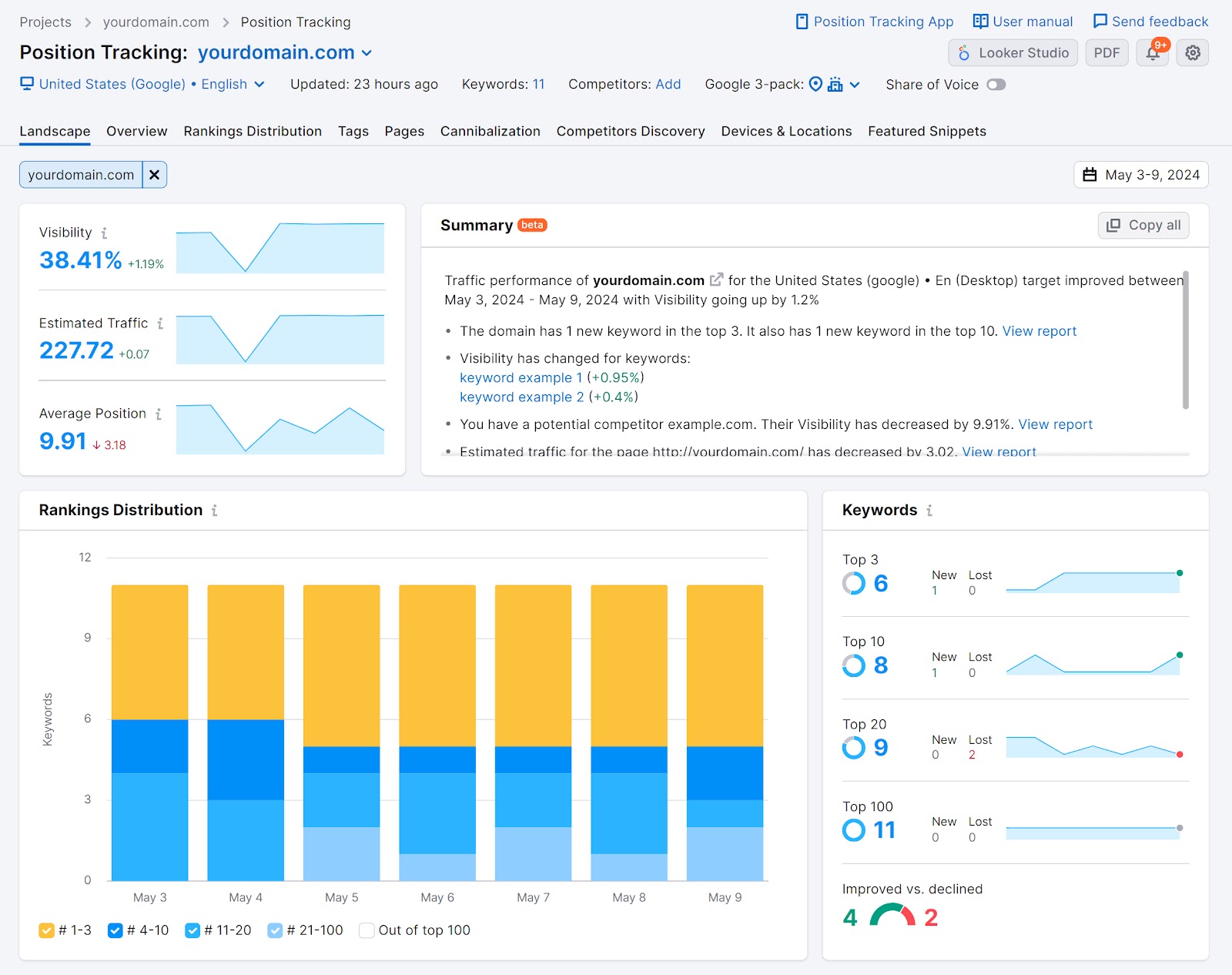
Scroll down to “Top Keywords” to see the positions and visibility for the keywords you entered.
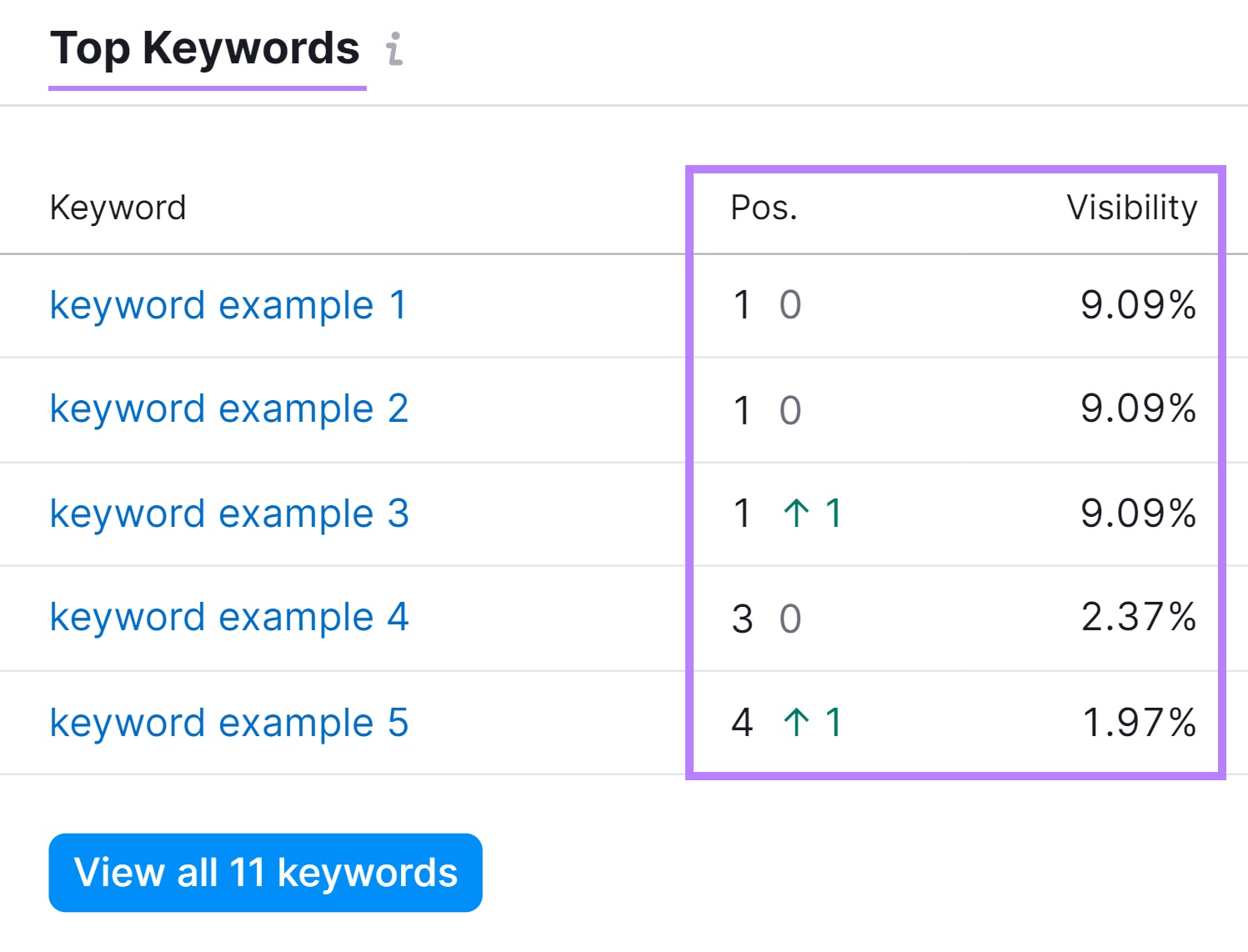
With a tracking campaign, you can monitor your (and your competitors’) rankings on a daily basis. And with custom notifications, it’s easy to stay on top of any changes in rankings.
Get to the Top of Google with Semrush
Now, you’re equipped with the essential insights and strategies to get your site to the top of Google. But why stop there?
Take the next step by signing up for a free Semrush account.
From in-depth keyword research to backlink analysis, technical optimization, and much more, Semrush has everything you need to maximize your SEO performance.
